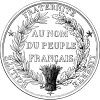បារាំង
អត្ថបទនេះត្រូវបានសរសេរជាភាសាផ្សេង ដែលមិនមែនជាភាសាខ្មែរ។ បើសិនជាអត្ថបទទុកសម្រាប់អ្នកអានមកពី សហគមន៍នៃភាសាមួយនេះ វាគួរតែចែកចាយទៅវិគីភីឌាជាភាសានោះ។ សូមមើល បញ្ជីនៃគម្រោងវិគីភីឌាទាំងអស់។
| អត្ថបទនេះត្រូវការបកប្រែទៅជាភាសាខ្មែរ។ សូមមើល ច្រកចូលអត្ថបទនេះ លើក្រុមទំព័រដែលត្រូវការបំណកប្រែទៅជាភាសាខ្មែរ ដើម្បីពិភាក្សា ។ ប្រសិនបើ អត្ថបទមិនត្រូវបានសរសេរជាភាសាខ្មែរឡើងវិញទេ ក្នុងរយៈពេលពីរសប្ដាហ៍ទៀត អត្ថបទនឹងត្រូវចុះបញ្ជីដើម្បីលុបចោល និង/ឬ ប្ដូរវាទៅកាន់វិគីភីឌាជាភាសាដើមរបស់វាវិញ ។ បើសិនជាលោកអ្នក គ្រាន់តែចង់បិទស្លាកទំព័រនេះត្រូវការបំណកប្រែ សូមបញ្ចូល {{អាទេស.:ត្រូវការបកប្រែ | ទំ. = បារាំង | ភាសា = មិនស្គាល់ | ផ្ដល់យោបល់ = }} ~~~~ទៅខាងក្រោម នៃផ្នែក នៃក្រុមទំព័រនេះត្រូវការបំណកប្រែទៅជាភាសាខ្មែរ ។ |
ប្រទេសបារាំង (បារាំង: France ហ្វ្រង្សិ៍) ដោយមានឈ្មោះផ្លូវការថា សាធារណរដ្ឋបារាំង គឺជាប្រទេសឆ្លងទ្វីបមួយដែលមានទឹកដីចម្បងស្ថិតនៅតំបន់អឺរ៉ុបខាងលិចនិងមានទឹកដីក្រៅស្រុកមួយចំនួនស្ថិតនៅតាមទ្វីបអាមេរិកខាងត្បូង និងរួមទាំងមហាសមុទ្រអាត្លង់ទិក មហាសមុទ្រប៉ាស៊ីហ្វិក និងមហាសមុទ្រឥណ្ឌា។ តំបន់មាតុបុរៈរបស់ប្រទេសនេះលាតសន្ធឹងពីតំបន់រ៉ាំងនៅភាគខាងកើតទៅដល់មហាសមុទ្រអាត្លង់ទិកនៅភាគខាងលិច និងពីសមុទ្រមេឌីទែរ៉ានេនៅភាគខាងត្បូងដល់ផ្លូវទឹកអង់គ្លេស និងសមុទ្រខាងជើង។ ទឹកដីក្រៅប្រទេសរួមមាន៖ គុយយ៉ានបារាំងនៅអាមេរិកខាងត្បូង សង់ព្យែរនិងមីកូឡុងនៅសមុទ្រអាត្លង់ទិកខាងជើង ឥណ្ឌីបារាំងខាងលិច និងបណ្តុំកោះជាច្រើនទៀតនៅទ្វីបអូសេអានី និងមហាសមុទ្រឥណ្ឌា។ ដោយសារតែមានទឹកដីជាប់មាត់សមុទ្រច្រើន ប្រទេសបារាំងមានតំបន់សេដ្ឋកិច្ចផ្តាច់មុខដ៏ធំបំផុតលើពិភពលោក។ នៅប៉ែកអឺរ៉ុប បារាំងមានព្រំប្រទល់ជាប់នឹងប្រទេសបែលហ្សិក លុចសំបួ អាល្លឺម៉ង់ ស្វីស ម៉ូណាកូ អ៊ីតាលី អង់ដូរ៉ា និងប្រទេសអេស្ប៉ាញ រីឯនៅទ្វីបអាមេរិកវិញ វាមានព្រំប្រទល់ជាប់ប្រទេសហុល្លង់ ស៊ូរីណាម និងប្រទេសប្រេស៊ីល។ បារាំងមានតំបន់អាំងតេក្រាលចំនួនដប់ប្រាំបី (ប្រាំនៅក្រៅប្រទេស) ដែលលាតសន្ធឹងលើផ្ទៃដីសរុប ៦៤៣,៨០១ គីឡូម៉ែត្រក្ររ៉េ និងមានប្រជាជនជាង ៦៧ លាននាក់ (គិតត្រឹមខែឧសភា ឆ្នាំ២០២១)។ ប្រទេសបារាំងគឺជាសាធារណរដ្ឋឯកភូតប្រកាន់ប្រព័ន្ធពាក់កណ្តាលប្រធានាធិបតីនិយម ដែលមានរដ្ឋធានីឈ្មោះថាប៉ារីសដោយវាត្រូវជាទីក្រុងធំបំផុតក្នុងប្រទេស និងជាមជ្ឈមណ្ឌលវប្បធម៌ និងពាណិជ្ជកម្មដ៏សំខាន់។ តំបន់ទីក្រុងសំខាន់ៗផ្សេងទៀតរួមមាន៖ លីយ៉ុង ម៉ាសែល ធូលូស ប័រដូ លីល និងនីស។
| République française (ភាសាបារាំង) | |
|---|---|
បាវចនា "Liberté, égalité, fraternité" "សេរីភាព សមភាព ភាតរភាព" | |
ភ្លេងជាតិ "La Marseillaise" | |
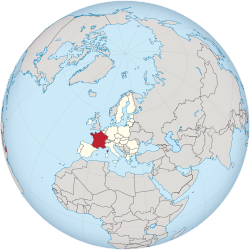 ទីតាំងប្រទេសបារាំង (ក្រហម) នៅលើភូគោល | |
| រដ្ឋធានី និង ទីក្រុងធំបំផុត | ប៉ារីស 48°51′N 2°21′E / 48.850°N 2.350°E |
| ភាសាផ្លូវការ | ភាសាបារាំង |
| សាសនា (ឆ្នាំ ២០២២) |
|
| រដ្ឋាភិបាល | រដ្ឋឯកភូត សាធារណរដ្ឋអាស្រ័យរដ្ឋធម្មនុញ្ញប្រកាន់ប្រព័ន្ធពាក់កណ្តាលប្រធានាធិបតីនិយម |
- ប្រធានាធិបតី | អេម៉ានុយអែល ម៉ាក្រុង |
- នាយករដ្ឋមន្ត្រី | អេលីហ្សាប៊េត ប៊ន |
| នីតិបញ្ញត្តិ | សភាតំណាងរាស្ត្រ |
| ព្រឹទ្ធសភា | |
- សភាជាន់ទាប | រដ្ឋសភា |
| និម្មិតកម្ម | |
- រាជាណាចក្រហ្វ្រង់ស៊ា (បង្រួបបង្រួមដោយស្តេចក្លូវីសទី១) | ៤៨១ |
- សន្ធិសញ្ញាវែរដុង | សីហា ៨៤៣ |
- ព្រះរាជាណាចក្រ | ៣ កក្កដា ៩៨៧ |
- ប្រកាសជាសាធារណរដ្ឋ | ២២ កញ្ញា ១៧៩២ |
- រដ្ឋធម្មនុញ្ញបច្ចុប្បន្ន | ៤ តុលា ១៩៥៨ |
| ក្រឡាផ្ទៃ | |
- ផ្ទៃសរុប | ៦៤០,៦៧៩ គ.ម២ (ទី៤២) |
- ផ្ទៃទឹក (%) | ០.៨៦ (ត្រឹមឆ្នាំ២០១៥) |
- បារាំងដីគោក (IGN) | ៥៥១,៦៩៥ គម២ (ទី៥០) |
- បារាំងដីគោក (កាដាស្ត្រេ) | ៥៤៣,៩៤០ គម២ (ទី៥០) |
| ប្រជាជន | |
- ប៉ាន់ស្មាន (ឆ្នាំ ២០២១) | |
- ដង់ស៊ីតេ | ១១៦ នាក់/គ.ម២ (ទី៨៩) |
| GDP (PPP) | ប៉ាន់ស្មាន (ឆ្នាំ ២០២១) |
- សរុប | |
- ក្នុងម្នាក់ | |
| GDP (ចារឹក) | ប៉ាន់ស្មាន (ឆ្នាំ ២០២១) |
- សរុប | |
- ក្នុងម្នាក់ | |
| ជីនី (២០១៩) | ទាប |
| HDI (២០១៩) | ខ្ពស់ណាស់ · ទី២៦ |
| រូបិយវត្ថុ |
|
| ល្វែងម៉ោង | UTC+១ (ម៉ោងអឺរ៉ុបកណ្តាល) |
- រដូវក្តៅ (DST) | UTC+២ (ម៉ោងរដូវក្តៅអឺរ៉ុបកណ្តាល) |
| ទម្រង់កាលបរិច្ឆេទ | dd/mm/yyyy (គ.ស.) |
| បណ្ដាញចែកចាយអគ្គិសនី | 230 V–50 Hz |
| ទិសបើកបរ | ស្តាំ |
| កូដហៅទូរស័ព្ទ | ៣៣ |
| ដែនកម្រិតខ្ពស់ | .fr |
ទឹកដីបារាំងសព្វថ្ងៃបានទទួលវត្តមានមនុស្សដំបូងៗតាំងពីស័កប៉ាលេអូលីទិកមកម្លេះ ហើយទឹកដីមាតុបុរៈបារាំងត្រូវកុលសម្ព័ន្ធសែលតិកមួយក្រុមដែលគេស្គាល់ថា"ហ្គោល"ចូលមកតាំងទីលំនៅក្នុងអំឡុងយុគដែក។ ពួករ៉ូមបានកាត់តំបន់នេះបញ្ចូលជាផ្នែកមួយនៃទឹកដីខ្លួននៅក្នុងឆ្នាំ ៥១ មុន គ.ស ដែលជាហេតុនាំឱ្យវប្បធម៌ហ្កាល់ឡូ-រ៉ូម៉ាំងលេចឡើង និងត្រូវជាមូលដ្ឋានគ្រឹះនៃភាសាបារាំង។ ពួកហ្វ្រង់ដែលជាក្រុនជនជាតិជឺម៉ាំងមួយបានបង្កើតព្រះរាជាណាចក្រហ្វ្រង់ស៊ា ហើយបានក្លាយជាមាតុបេះដូងនៃចក្រភពការអូលីនជាន។ សន្ធិសញ្ញាវ៉ែដុងនៃឆ្នាំ ៨៤៣ បានបែងចែកចក្រភពនោះដោយមានរដ្ឋហ្វ្រង់ស៊ាខាងលិចក្លាយទៅជាព្រះរាជាណាចក្របារាំងនៅក្នុងឆ្នាំ៩៨៧។ នៅយុគសម័យកណ្តាល បារាំងបានក្លាយជាអាណាចក្រសក្តិភូមិដ៏មានឥទ្ធិពលមួយ ហើយមានវិមជ្ឈការខ្ពស់។ ស្តេចហ្វីលីពទី២ បានពង្រឹងអំណាចរាជវង្សប្រកបដោយជោគជ័យ ហើយបានកម្ចាត់ចោលនូវគូប្រជែងរបស់ទ្រង់ដើម្បីបង្កើនវិសាលភាពរាជ្យទឹកដីបារាំង។ នៅចុងរជ្ជកាលរបស់ព្រះអង្គ ប្រទេសបារាំងបានក្លាយទៅជារដ្ឋដ៏មានឥទ្ធិពលបំផុតនៅទ្វីបអឺរ៉ុប។ ចាប់ពីពាក់កណ្តាលសតវត្សទី១៤ ដល់ពាក់កណ្តាលសតវត្សទី១៥ ប្រទេសបារាំងបានធ្លាក់ចូលទៅក្នុងជម្លោះរាជវង្សជាបន្តបន្ទាប់ដែលមានប្រទេសអង់គ្លេសជាប់ពាក់ព័ន្ធ គេតែងសម្តៅលើជម្លោះនេះថាសង្រ្គាមមួយរយឆ្នាំ ហើយអត្តសញ្ញាណរបស់បារាំងថ្មីបានលេចឡើងជាលទ្ធផល។ នៅក្នុងសម័យបុនវុឌ្ឍិសិល្បៈ (Renaissance) ប្រទេសបារាំងបានឆ្លងកាត់វឌ្ឍនភាពសិល្បៈនិងវប្បធម៌ ជម្លោះជាមួយរាជត្រកូលហាបស្បួក និងនិម្មិតកម្មនៃចក្រភពអាណានិគមលំដាប់ពិភពលោកដែលដល់សតវត្សទី២០ វាក៏ក្លាយជាចក្រភពមហាអំណាចធំទីពីរនៅលើភពផែនដី។ នៅពាក់កណ្តាលទីពីរនៃសតវត្សទី១៦ បារាំងត្រូវប្រឈមនឹងសង្រ្គាមស៊ីវិលសាសនារវាងអ្នកកាន់និកាយកាតូលិកនិងពួកហ៊ូហ្គូណូដែលជាហេតុនាំឱ្យប្រទេសចុះទន់ខ្សោយយ៉ាងខ្លាំង។ ប្រទេសបារាំងបានលេចចេញជាមហាអំណាចសារជាថ្មីនៅអឺរ៉ុបក្នុងសតវត្សទី១៧ ក្រោមការដឹកនាំរបស់ស្តេចនាមល្វីទី១៤ បន្ទាប់ពីទ្រង់បានបិទបញ្ចប់ឆាកសង្រ្គាមសាមសិបឆ្នាំ។ កង្វះគោលនយោបាយសេដ្ឋកិច្ច ពន្ធវិសមភាព និងសង្រ្គាមជាញឹកញាប់ (ជាពិសេសការបរាជ័យនៅក្នុងសង្គ្រាមប្រាំពីរឆ្នាំ និងការចូលធ្វើអន្តរាគមន៍នៅក្នុងសង្គ្រាមឯករាជ្យអាមេរិក) បាននាំឱ្យព្រះរាជាណាចក្រធ្លាក់ក្នុងស្ថានភាពសេដ្ឋកិច្ចមិនជាក់លាក់នៅចុងសតវត្សទី១៨។ បញ្ហាទាំងនេះបានធ្វើឱ្យបដិវត្តន៍បារាំងផ្ទុះឡើងនៅក្នុងឆ្នាំ១៧៨៩ ដែលជាលទ្ធផល របបចាស់ (Ancien Régime) ត្រូវបានគេផ្តួលរំលំ និងការបង្កើតនូវសេចក្តីប្រកាសសិទ្ធិមនុស្ស ដែលបង្ហាញពីឧត្តមគតិរបស់ប្រទេសនេះរហូតមកដល់ពេលបច្ចុប្បន្ន។
ប្រទេសបារាំងបានឈានដល់ចំណុចកំពូលខាងផ្នែកនយោបាយ និងយោធានៅដើមសតវត្សទី១៩ ក្រោមការដឹកនាំរបស់ណាប៉ូលេអុងបូណាប៉ារត៍ ដោយពេលនោះបារាំងបានដណ្តើមកាន់កាប់ទឹកដីមួយភាគធំនៃទ្វីបអឺរ៉ុប ហើយបានបង្កើតចក្រភពបារាំងទីមួយឡើង។ បដិវត្តន៍បារាំង និងសង្គ្រាមណាប៉ូលេអូនិកបានផ្លាស់ប្តូររូបរាងដំណើរប្រវត្តិសាស្ត្រអឺរ៉ុប និងពិភពលោកទាំងមូល។ ការដួលរលំនៃចក្រភពទីមួយបាននាំឱ្យឥទ្ធិពលបារាំងធ្លាក់ចុះជាបន្តបន្ទាប់ ដែលក្នុងនោះប្រទេសបារាំងត្រូវប្រឈមនឹងវិបត្តិរដ្ឋាភិបាលរហូតដល់ការបង្កើតឡើងនៃសាធារណរដ្ឋបារាំងទីបីនៅក្រោយសង្គ្រាមបារាំង-ព្រុសក្នុងឆ្នាំ១៨៧០។ នៅក្នុងទសវត្សរ៍បន្ទាប់ៗ គេបានឆ្លងកាត់សម័យសុទិដ្ឋិនិយមនៅបារាំងដូចជា ការរីកចម្រើនផ្នែកវប្បធម៌ និងវិទ្យាសាស្ត្រ ក៏ដូចជាភាពចម្រុងចម្រើនផ្នែកសេដ្ឋកិច្ចដែលគេនិយមស្គាល់ថា "សម័យសោភ័ណ" (Belle Époque)។ ប្រទេសបារាំងគឺជាប្រទេសមួយក្នុងចំណោមប្រទេសដែលចូលរួមក្នុងសង្គ្រាមលោកលើកទី១ ដោយជាលទ្ធផល វាបានទទួលបានជ័យជម្នះតែត្រូវបាត់បង់ជីវិតមនុស្ស និងសេដ្ឋកិច្ចជាច្រើន។ ប្រទេសនេះក៏ជាប្រទេសមួយក្នុងចំណោមមហាអំណាចសម្ព័ន្ធមិត្តនៃសង្គ្រាមលោកលើកទី២ ផងដែរប៉ុន្តែមិនយូរប៉ុន្មានវាក៏ត្រូវទទួលរងការត្រួតត្រាពីសំណាក់សត្រូវរបស់ខ្លួនហៅ មហាអំណាចអ័ក្ស នៅក្នុងឆ្នាំ១៩៤០។ បន្ទាប់ពីបានរំដោះនៅឆ្នាំ១៩៤៤ សាធារណរដ្ឋទីបួនដែលមានអត្ថិភាពដ៏ខ្លីត្រូវបានបង្កើតឡើង ហើយក្រោយមកត្រូវបានរំលាយនៅក្នុងដំណើរនៃសង្គ្រាមអាល់ហ្សេរី។ សាធារណរដ្ឋទីប្រាំបច្ចុប្បន្នត្រូវបានបង្កើតឡើងនៅក្នុងឆ្នាំ១៩៥៨ ដោយមហាវីរបុរសបារាំងគឺលោកសាល ដឺ ហ្គោល។ អាល់ហ្សេរី និងរួមទាំងទឹកដីអាណានិគមបារាំងភាគច្រើនបានទទួលឯករាជ្យនៅទសវត្សរ៍ឆ្នាំ១៩៦០ ដោយភាគច្រើនបានរក្សាទំនាក់ទំនងសេដ្ឋកិច្ច និងយោធាយ៉ាងជិតស្និទ្ធជាមួយបារាំងមកដល់សព្វថ្ងៃ។
ប្រទេសបារាំងរក្សាបាននូវឋានៈជាមជ្ឈមណ្ឌលសិល្បៈ វិទ្យាសាស្ត្រ និងទស្សនវិជ្ជាសកល។ វាជាប្រទេសដែលមានចំនួនបេតិកភណ្ឌពិភពលោកច្រើនបំផុតទីប្រាំរបស់អង្គការយូណេស្កូ និងជាគោលដៅទេសចរណ៍ឈានមុខគេរបស់ពិភពលោកដោយទទួលបានភ្ញៀវទេសចរបរទេសជាង ៨៩ លាននាក់នៅក្នុងឆ្នាំ២០១៨។ ប្រទេសបារាំងគឺជាប្រទេសអភិវឌ្ឍមួយដែលមានសេដ្ឋកិច្ចធំជាងគេទី ៧ នៅលើពិភពលោកបើគិតតាមផលិតផលក្នុងស្រុកសរុបជាមធ្យម និងធំជាងគេទី ៩ បើគិតតាមយុគភាពនៃអំណាចទិញ។ បើនិយាយពីទ្រព្យសម្បត្តិសរុបតាមគ្រួសារ វាជាប់ចំណាត់ថ្នាក់ទីបួននៅលើពិភពលោក។ ប្រទេសបារាំងមានកម្រិតអប់រំ ការថែទាំសុខភាព អាយុសង្ឃឹមរស់ និងការអភិវឌ្ឍមនុស្សខ្ពស់។ បារាំងនៅតែអាចរក្សាតំណែងជាមហាអំណាចមួយបាននៅក្នុងកិច្ចការពិភពលោក ដោយជាសមាជិកអចិន្ត្រៃយ៍មួយក្នុងចំណោមសមាជិកអចិន្ត្រៃយ៍ទាំងប្រាំនៃក្រុមប្រឹក្សាសន្តិសុខអង្គការសហប្រជាជាតិ និងជារដ្ឋអាវុធនុយក្លេអ៊ែរផ្លូវការមួយផងដែរ។ ប្រទេសបារាំងគឺជាសមាជិកស្ថាបនិក និងឈានមុខគេនៃសហភាពអឺរ៉ុប និងតំបន់អឺរ៉ូ ក៏ដូចជាសមាជិកសំខាន់នៃក្រុមប្រាំពីរ (G7) អង្គការសន្ធិសញ្ញាអាត្លង់ទិកខាងជើង (អូតង់ ឬណាតូ) អង្គការសម្រាប់កិច្ចសហប្រតិបត្តិការ និងអភិវឌ្ឍន៍សេដ្ឋកិច្ច (OECD) និង ហ្វ្រង់កូហ្វូនី (Francophonie)។
និរុត្តិសាស្ត្រ
The name "France" comes from the Latin Francia, which means "country of the Franks". There are various theories as to the origin of the name Franks: one is that it is derived from the Proto-Germanic word frankon which translates as javelin or lance as the throwing axe of the Franks was known as a francisca. Another proposed etymology is that in an ancient Germanic language, Frank means free as opposed to slave.[ត្រូវការអំណះអំណាង]
ប្រវត្តិសាស្ត្រ
សម័យបុរេប្រវត្តិសាស្ត្រ
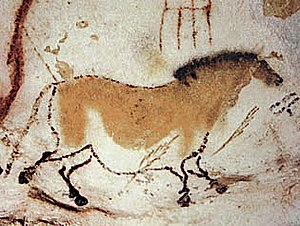
The oldest traces of human life (homo) in what is now France date from approximately 1.8 million years ago. Humans were then confronted by a hard and variable climate, marked by several glacial eras which led them to a nomadic hunter-gatherer life. France has a large number of decorated caves from the upper Paleolithic era, including one of the most famous and best preserved: Lascaux (approximately 18,000 BC).
At the end of the last glacial period (10,000 BC), the climate softened and from approximately 7,000 BC, this part of Western Europe entered the Neolithic era and its inhabitants became sedentary. After strong demographic and agricultural development between the 4th and 3rd millennia, metallurgy appeared at the end of the 3rd millennium, initially working gold, copper and bronze, and later iron. France has numerous megalithic sites from the Neolithic period, including the exceptionally dense Carnac stones site (approximately 3,300 BC).
ហ្គូល
In 600 BC, Ionian Greeks, originating from Phocaea, founded the colony of Massalia (present-day Marseille), on the shores of the Mediterranean Sea. This makes it France's oldest city. At the same time, some Gallic Celtic tribes penetrated parts of the current territory of France, and this occupation spread to the rest of France between the 5th and 3rd century BC.

The concept of Gaul emerged at that time; it corresponds to the territories of Celtic settlement ranging between the Rhine, the Atlantic Ocean, the Pyrenees and the Mediterranean. The borders of modern France are roughly the same as those of ancient Gaul, which was inhabited by Celtic Gauls. Gaul was then a prosperous country, of which the southernmost part was heavily subject to Greek and Roman influences. However, around 390 BC, the Gallic chieftain Brennus and his troops made their way to Italy through the Alps, defeated the Romans in the Battle of the Allia, and besieged and ransomed Rome. The Gallic invasion left Rome weakened and the Gauls continued to harass the region until 345 BC, when they entered into a formal peace treaty with Rome. But the Romans and the Gauls would maintain an adversarial relationship for the next several centuries and the Gauls would remain a threat in Italia.
Around 125 BC, the south of Gaul was conquered by the Romans, who called this region Provincia Romana ("Roman Province"), which over time evolved into the name Provence in French. Julius Caesar conquered the remainder of Gaul and overcame a revolt carried out by the Gallic chieftain Vercingetorix in 52 BC. Gaul was divided by Augustus into Roman provinces. Many cities were founded during the Gallo-Roman period, including Lugdunum (present-day Lyon), which is considered to be the capital of the Gauls. These cities were built in traditional Roman style, with a forum, a theatre, a circus, an amphitheatre and thermal baths. The Gauls mixed with Roman settlers and eventually adopted Roman speech (Latin, from which the French language evolved) and Roman culture. The Roman polytheism merged with the Gallic paganism into the same syncretism.
From the 250s to the 280s AD, Roman Gaul suffered a serious crisis with its "limes" or fortified borders protecting the Empire being attacked on several occasions by barbarians. Nevertheless, the situation improved in the first half of the 4th century, which was a period of revival and prosperity for Roman Gaul. In 312, the emperor Constantin I converted to Christianity. Christians, persecuted until then, increased rapidly across the entire Roman Empire. But, from the beginning of the 5th century, the Barbarian Invasions resumed, and Germanic tribes, such as the Vandals, Suebi and Alans crossed the Rhine and settled in Gaul, Spain and other parts of the collapsing Roman Empire.
Kingdom of Francia (3rd century–843)
At the end of the Antiquity period, ancient Gaul was divided into several Germanic kingdoms and a remaining Gallo-Roman territory, known as the Kingdom of Syagrius (West). Simultaneously, Celtic Britons, fleeing the Anglo-Saxon settlement of Britain, settled the western part of Armorica. As a result, the Armorican peninsula was renamed Brittany, Celtic culture was revived and independent petty kingdoms arose in this region.

The pagan Franks, from whom the ancient name of "Francie" was derived, originally settled the north part of Gaul, but under Clovis I conquered most of the other kingdoms in northern and central Gaul. In 498, Clovis I was the first Germanic conqueror after the fall of the Roman Empire to convert to Catholic Christianity, rather than Arianism; thus France was given the title "Eldest daughter of the Church" (បារាំង: La fille aînée de l’Église) by the papacy, and French kings would be called "the Most Christian Kings of France" (Rex Christianissimus).
The Franks embraced the Christian Gallo-Roman culture and ancient Gaul was eventually renamed Francia ("Land of the Franks"). The Germanic Franks adopted Romanic languages, except in north Gaul where Roman settlements were less dense and where Germanic languages emerged. Clovis made Paris his capital and established the Merovingian dynasty, but his kingdom would not survive his death. The Franks treated land purely as a private possession and divided it among their heirs, so four kingdoms emerged from Clovis's: Paris, Orléans, Soissons, and Rheims.
The last Merovingian kings lost power to their mayors of the palace (head of household). One mayor of the palace, Charles Martel, defeated an Islamic invasion of Gaul at the Battle of Tours (732) and earned respect and power within the Frankish kingdoms. His son, Pepin the Short, seized the crown of Francia from the weakened Merovingians and founded the Carolingian dynasty. Pepin's son, Charlemagne, reunited the Frankish kingdoms and built a vast empire across Western and Central Europe.
Proclaimed Holy Roman Emperor by Pope Leo III and thus establishing in earnest the French government's longtime historical association with the Catholic Church, Charlemagne tried to revive the Western Roman Empire and its cultural grandeur.

Charlemagne's son, Louis I (emperor 814–840), kept the empire united; however, this Carolingian Empire would not survive his death. In 843, under the Treaty of Verdun, the empire was divided between Louis' three sons, with East Francia going to Louis the German, Middle Francia to Lothair I, and West Francia to Charles the Bald. West Francia approximated the area occupied by, and was the precursor, to modern France.
During the 9th and 10th centuries, continually threatened by Viking invasions, France became a very decentralised state: the nobility's titles and lands became hereditary, and the authority of the king became more religious than secular and thus was less effective and constantly challenged by powerful noblemen. Thus was established feudalism in France. Over time, some of the king's vassals would grow so powerful that they often posed a threat to the king. For example, after the Battle of Hastings in 1066, William the Conqueror added "King of England" to his titles, becoming both the vassal to (as Duke of Normandy) and the equal of (as king of England) the king of France.
Kingdom of France (843–1791)

The Carolingian dynasty ruled France until 987, when Hugh Capet, Duke of France and Count of Paris, was crowned King of the Franks. His descendants – the Capetians, the House of Valois, and the House of Bourbon – progressively unified the country through wars and dynastic inheritance into the Kingdom of France, which was fully declared in 1190 by Philip II Augustus. Gerbert d'Aurillac (Gerbert of Aurillac) was the first French pope; his reign as Pope Sylvester II lasted from 999 to 1003.
The Albigensian Crusade was launched in 1209 to eliminate the heretical Cathars in the south-western area of modern-day France. In the end, the Cathars were exterminated and the autonomous County of Toulouse was annexed into the kingdom of France. Later Kings expanded their territory to cover over half of modern continental France, including most of the North, Centre and West of France. Meanwhile, the royal authority became more and more assertive, centred around a hierarchically conceived society distinguishing nobility, clergy, and commoners.
Charles IV the Fair died without an heir in 1328. Under the rules of the Salic law the crown of France could not pass to a woman nor could the line of kingship pass through the female line. Accordingly, the crown passed to Philip of Valois, a cousin of Charles, rather than through the female line to Charles' nephew, Edward, who would soon become Edward III of England. During the reign of Philip of Valois, the French monarchy reached the height of its medieval power.
However, Philip's seat on the throne was contested by Edward III of England and in 1337, on the eve of the first wave of the Black Death, England and France went to war in what would become known as the Hundred Years' War. The exact boundaries changed greatly with time, but French landholdings of the English Kings remained extensive for decades.
With charismatic leaders, such as Joan of Arc and La Hire, strong French counterattacks won back English continental territories. Like the rest of Europe, France was struck by the Black Death. Around 1340, France had a population of approximately 17 million, which by the end of the pandemic had declined by about one-half.

The French Renaissance saw a long set of wars, known as the Italian Wars, between the Kingdom of France and the powerful Holy Roman Empire. It also saw the first standardization of the French language, which would become the official language of France and the language of Europe's aristocracy. French explorers, such as Jacques Cartier or Samuel de Champlain, claimed lands in the Americas for France, paving the way for the expansion of the First French colonial empire.
The rise of Protestantism in Europe led France to a civil war known as the French Wars of Religion, where, in the most notorious incident, thousands of Huguenots were murdered in the St. Bartholomew's Day massacre of 1572. The Wars of Religion were ended by Henry IV's Edict of Nantes, which granted some freedom of religion to the Huguenots.
Under Louis XIII, the energetic Cardinal Richelieu reinforced the centralization of the state, royal power and French dominance in Europe, foreshadowing the reign of Louis XIV. During Louis XIV's minority and the regency of Queen Anne and Cardinal Mazarin, a period of trouble known as the Fronde occurred in France, which was at that time at war with Spain. This rebellion was driven by the great feudal lords and sovereign courts as a reaction to the rise of royal power in France.

The monarchy reached its peak during the 17th century and the reign of Louis XIV. By turning powerful feudal lords into courtiers at the Palace of Versailles, Louis XIV's personal power became unchallenged. Remembered for his numerous wars, he made France the leading European power. France possessed the largest population in Europe (see Demographics of France) and had tremendous influence over European politics, economy, and culture. French became the most-used language in diplomacy, science, literature and international affairs, and remained so until the 20th century. France obtained many overseas possessions in the Americas, Africa and Asia. Louis XIV revoked the Edict of Nantes, forcing thousands of Huguenots into exile.
Under Louis XV, France lost New France and most of its Indian possessions after its defeat in the Seven Years' War, which ended in 1763. Its continental territory kept growing, however, with notable acquisitions such as Lorraine (1766) and Corsica (1770). An unpopular king, Louis XV's weak rule, his ill-advised financial, political and military decisions, and his debauchery discredited the monarchy and arguably led to the French Revolution 15 years after his death.
Louis XVI, Louis XV's grandson, actively supported the Americans, who were seeking their independence from Great Britain (realized in the Treaty of Paris (1783)). The example of the American Revolution and the financial crisis which followed France's involvement in it were two of many contributing factors to the French Revolution.
Much of the Enlightenment occurred in French intellectual circles, and major scientific breakthroughs and inventions, such as the discovery of oxygen (1778) and the first hot air balloon carrying passengers (1783), were achieved by French scientists. French explorers, such as Bougainville and Lapérouse, took part in the voyages of scientific exploration through maritime expeditions around the globe. The Enlightenment philosophy, in which reason is advocated as the primary source for legitimacy and authority, undermined the power of and support for the monarchy and helped pave the way for the French Revolution.
Republics and Empires (1792–)
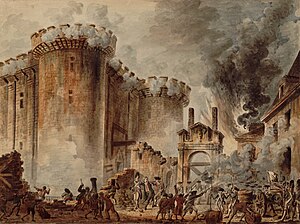
After the storming of the Bastille on 14 July 1789, the absolute monarchy was abolished and France became a constitutional monarchy. Through the Declaration of the Rights of Man and of the Citizen, France established fundamental rights for French citizens (who could only be male). The Declaration affirms "the natural and imprescriptible rights of man" to "liberty, property, security and resistance to oppression". It called for the destruction of aristocratic privileges and proclaimed freedom and equal rights for all men, as well as access to public office based on talent rather than birth.
របបរាជានិយមត្រូវបានរឹតបន្តឹង ហើយប្រជាពលរដ្ឋទាំងអស់ត្រូវមានសិទ្ធិចូលរួមក្នុងដំណើរការនីតិបញ្ញត្តិ។ សេរីភាពនៃការបញ្ចេញមតិ និងសារព័ត៌មានត្រូវបានប្រកាស ហើយការចាប់ខ្លួនតាមអំពើចិត្តមិនត្រូវបានអនុញ្ញាត។ សេចក្តីថ្លែងការណ៍ក៏បានអះអាងនូវគោលការណ៍នៃអធិបតេយ្យភាពដ៏ពេញនិយម ដែលផ្ទុយពីសិទ្ធិដ៏ទេវភាពរបស់ស្តេចដែលកំណត់លក្ខណៈនៃរាជាធិបតេយ្យបារាំង និងសមភាពសង្គមក្នុងចំណោមប្រជាពលរដ្ឋ ដោយលុបបំបាត់ឯកសិទ្ធិរបស់អភិជន និងបព្វជិត។
While Louis XVI, as a constitutional king, enjoyed popularity among the population, his disastrous flight to Varennes seemed to justify rumours he had tied his hopes of political salvation to the prospects of foreign invasion. His credibility was deeply undermined to the extent that the abolition of the monarchy and establishment of a republic became an increasing possibility.
European monarchies gathered against the new régime, to restore the French absolute monarchy. The foreign threat exacerbated France's political turmoil and deepened the sense of urgency among the various factions and war was declared against Austria on 20 April 1792. Mob violence occurred during the insurrection of 10 August 1792 and the following month. As a result of this violence and the political instability of the constitutional monarchy, the Republic was proclaimed on 22 September 1792.

Louis XVI was convicted of treason and guillotined in 1793. Facing increasing pressure from European monarchies, internal guerrilla wars and counterrevolutions (such as the War in the Vendée or the Chouannerie), the young Republic fell into the Reign of Terror. Between 1793 and 1794, between 16,000 and 40,000 people were executed. In Western France, the civil war between the Bleus ("Blues", supporters of the Revolution) and the Blancs ("Whites", supporters of the Monarchy) lasted from 1793 to 1796 and led to the loss of between 200,000 and 450,000 lives.
Both foreign armies and French counterrevolutionnaries were crushed and the French Republic survived. Furthermore, it extended greatly its boundaries and established "Sister Republics" in the surrounding countries. As the threat of a foreign invasion receded and France became mostly pacified, the Thermidorian Reaction put an end to Robespierre's rule and to the Terror. The abolition of slavery and male universal suffrage, enacted during this radical phase of the revolution, were cancelled by subsequent governments.
After a short-lived governmental scheme, Napoleon Bonaparte seized control of the Republic in 1799 becoming First Consul and later Emperor of the French Empire (1804–1814/1815). As a continuation of the wars sparked by the European monarchies against the French Republic, changing sets of European Coalitions declared wars on Napoleon's Empire. His armies conquered most of continental Europe, while members of the Bonaparte family were appointed as monarchs in some of the newly established kingdoms.
These victories led to the worldwide expansion of French revolutionary ideals and reforms, such as the Metric system, the Napoleonic Code and the Declaration of the Rights of Man. After the catastrophic Russian campaign, Napoleon was defeated and the Bourbon monarchy restored. About a million Frenchmen died during the Napoleonic Wars.

After his brief return from exile, Napoleon was finally defeated in 1815 at the Battle of Waterloo, the monarchy was re-established (1815–1830), with new constitutional limitations. The discredited Bourbon dynasty was overthrown by the July Revolution of 1830, which established the constitutional July Monarchy, which lasted until 1848, when the French Second Republic was proclaimed, in the wake of the European Revolutions of 1848. The abolition of slavery and male universal suffrage, both briefly enacted during the French Revolution were re-enacted in 1848.
In 1852, the president of the French Republic, Louis-Napoléon Bonaparte, Napoleon I’s nephew, was proclaimed emperor of the second Empire, as Napoleon III. He multiplied French interventions abroad, especially in Crimea, in Mexico and Italy. Napoleon III was unseated following defeat in the Franco-Prussian War of 1870 and his regime was replaced by the Third Republic.
France had colonial possessions, in various forms, since the beginning of the 17th century. In the 19th and 20th centuries, its global overseas colonial empire extended greatly and became the second largest in the world behind the British Empire. Including metropolitan France, the total area of land under French sovereignty almost reached 13 million square kilometres in the 1920s and 1930s, 8.6% of the world's land.
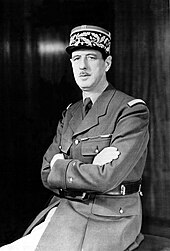
France was a member of the Triple Entente when World War I broke out. A small part of Northern France was occupied, but France and its allies emerged victorious against the Central Powers, at a tremendous human and material cost. World War I left 1.4 million French soldiers dead, 4% of its population, between 27 and 30% of the conscript classes of 1912–1915.
The interbellum years were marked by intense international tensions and a variety of social reforms introduced by the Popular Front government (Annual leave, working time reduction, women in Government among others). France was occupied following the German Blitzkrieg campaign in World War II, with metropolitan France divided into a German occupation zone in the north and Vichy France, a newly established authoritarian regime collaborating with Germany, in the south. The Allies and the French Resistance eventually emerged victorious from the Axis powers and French sovereignty was restored.
The Fourth Republic was established after World War II and saw spectacular economic growth (les Trente Glorieuses). Suffrage was extended to women in 1944. France was one of the founding members of NATO (1949). France attempted to regain control of French Indochina but was defeated by the Viet Minh in 1954. Only months later, France faced a new conflict in Algeria. The debate over whether or not to keep control of Algeria, then home to over one million European settlers, wracked the country and nearly led to civil war.
In 1958, the weak and unstable Fourth Republic gave way to the Fifth Republic, which contained a strengthened Presidency. In the latter role, Charles de Gaulle managed to keep the country together while taking steps to end the war. The Algerian War was concluded with the Évian Accords in 1962 that led to Algerian independence. France granted independence progressively to its colonies. A vestige of the colonial empire are the French overseas departments and territories.
In the wake of the series of worldwide protests of 1968, the revolt of May 1968 had an enormous social impact. In France, it is considered to be the watershed moment when a conservative moral ideal (religion, patriotism, respect for authority) shifted towards a more liberal moral ideal.
ប្រទេសបារាំងបានឈានមុខគេក្នុងប្រទេសជាសមាជិកសហភាពអឺរ៉ុបដែលកំពុងស្វែងរកទុនលើសន្ទុះនៃសហជីពរូបិយវត្ថុដើម្បីបង្កើតឧបករណ៍នយោបាយ ការការពារ និងសន្តិសុខរបស់សហភាពអឺរ៉ុបដែលមានការរួបរួម និងមានសមត្ថភាពជាងមុន។
ភូមិសាស្ត្រ

Metropolitan France is situated mostly between latitudes 41° and 51° N, and longitudes 6° W and 10° E, on the western edge of Europe, and thus lies within the northern temperate zone.
From northeast to southwest, France shares borders with Belgium, Luxembourg, Germany, Switzerland, Italy, Monaco, Spain and Andorra. France also borders Suriname to its west and Brazil to its east and south, by way of the overseas region of French Guiana, which is considered an integral part of the Republic.
Corsica and the French mainland form Metropolitan France; Guadeloupe, Martinique, Réunion, and Mayotte form, with French Guiana, the overseas regions. These two integral groupings, along with several overseas collectivities and one territory, comprise the French Republic.
The European territory of France covers 547,030 square kilometres (211,209 sq mi), the largest among European Union members. France possesses a wide variety of landscapes, from coastal plains in the north and west to mountain ranges of the Alps in the south-east, the Massif Central in the south-central and Pyrenees in the south-west.
At 4,810.45 ម៉ែត្រs (15,782 ft) above sea level, the highest point in Western Europe, Mont Blanc, is situated in the Alps on the border between France and Italy. France also has extensive river systems such as the Seine, the Loire, the Garonne, and the Rhone, which divides the Massif Central from the Alps and flows into the Mediterranean Sea at the Camargue. Corsica lies off the Mediterranean coast.
France's total land area, with its overseas departments and territories (excluding Adélie Land), is 674,843 km2 (260,558 sq mi), 0.45% of the total land area on Earth. France possesses the second largest exclusive economic zone (EEZ) in the world, covering 11,035,000 km2 (4,260,637 sq mi), approximately 8% of the total surface of all the EEZs of the world, just behind the US (11,351,000 km2 or 4,382,646 sq mi).
Climate
The north and northwest have a temperate climate, while a combination of maritime influences, latitude and altitude produce a varied climate in the rest of Metropolitan France. In the south-east a Mediterranean climate prevails. In the west, the climate is predominantly oceanic with a high level of rainfall, mild winters and cool to warm summers. Inland the climate becomes more continental with hot, stormy summers, colder winters and less rain. The climate of the Alps and other mountainous regions is mainly alpine, with the number of days with temperatures below freezing over 150 per year and snow cover lasting for up to six months.
- Limestone cliffs of Normandy near Étretat
- Mediterranean vegetation (lavender) in Provence
- The plains of the Beauce
- Alpine climate in the French Alps
- Verdon Gorge in Provence
- Vineyards in Côte de Nuits, Burgundy
- Alpine climate in Mercantour National Park
- Tropical climate in Bora Bora (French Polynesia)
- Heathland in Pointe du Van, Western Brittany
- Oceanic climate and sandy beach in Arcachon Bay
- Semi-arid climate in Corsica
បរិស្ថាន

France was one of the first countries to create an environment ministry, in 1971. Although France is one of the most industrialised countries, it is ranked only seventeenth by carbon dioxide emissions, behind less populous nations such as Canada or Australia. This situation results from the France's decision to invest in nuclear power in 1974 after the 1973 oil crisis, which now accounts for 75% of France's electricity production and explains why France pollutes less than comparable countries.
Like all European Union members, France agreed to cut carbon emissions by at least 20% of 1990 levels by the year 2020, in comparison the US agreed to a cut of 4% of its emissions. In 2009, French carbon dioxide emissions per capita was lower than the Chinese.
France was set to impose a carbon tax in 2009 at 17 Euros per tonne of carbon emitted. The carbon tax would have brought in 4 billion Euros of revenue per year. But the tax was abandoned for various reasons, including that French companies would have difficulty competing with companies in neighbouring countries that would not have to pay such steep taxes on carbon emissions. Instituting a carbon tax was an unpopular political move for President Sarkozy.
In 2010, a study at Yale and Columbia universities ranked France the seventh most environmentally conscious country in the world.
Forests account for 28% of the land area of France. French forests are some of the most diversified of Europe, with more than 140 differents varieties of trees. There are nine national parks and 46 natural parks in France. France wants to convert 20% of its Exclusive Economic Zone to a Marine Protected Area by 2020.
លក្ខណៈទូទៅរបស់ប្រទេសបារាំង


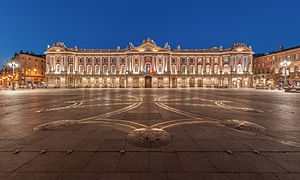

ផ្ទៃដី
មានផ្ទៃដីចំនួន ៥៥០០០០ គីឡូម៉ែត្រការេ។ ប្រទេសបារាំងលាតសន្ធឹងលើទឹកដីនៃទ្វីបអឺរ៉ុបភាគខាងលិច ប្រហែល១ភាគ១៥នៃផ្ទៃ ដីសហភាពអឺរ៉ុប ទាំងមូល ហើយជា ប្រទេសមួយដែលមានតំបន់សមុទ្រធំទូលាយ (ជា តំបន់សេដ្ឋកិច្ច ផ្ដាច់មុខលាតសន្ឋឹងលើផ្ទៃ១១លាន គម២)។
ស្ថានភាពដី
- តំបន់ទំនាប ៖ ២/៣ នៃផ្ទៃដីទាំងមូល.
- ប្រជុំភ្នំសំខាន់ៗ: ភ្នំអាល់ (Alpes) ភ្នំដែលមានកំពស់ខ្ពស់ជាងគេនៅអឺរ៉ុបភាគខាងលិច គឺភ្នំម៉ុងប្លង់ ដែលមានកំពស់ ៤៨០៧ម៉ែត្រ ភ្នំពីរេណ៉េ ភ្នំហ៊្សុយរ៉ា ភ្នំអាកឌែន ភ្នំម៉ាស៊្សីស សង់ត្រាល់ និងភ្នំវ៉ូហ្សឺ។
- តំបន់មាត់សមុទ្រ: ដោយមានព្រំប្រទល់ជាប់នឹងសមុទ្រចំនួន៤ សមុទ្រខាងជើង សមុទ្រឡាម៉ង់ មហាសមុទ្រ អាត្លង់ទិច និងសមុទ្រម៉េឌីទែរ៉ាណេ ប្រទេសបារាំងមាន ឆ្នេរសរុបប្រវែង ៥៥០០គីឡូម៉ែត្រ។
- ដែនដីសំខាន់ហ៊ុំព័ទ្ឋដោយ មហាសមុទ្រអាត្លង់ទិកនៅខាងលិច សមុទ្រម៉ង់ និង សមុទ្រខាងជើង(la mer du Nord)នៅខាងជើង ប្រទេសបែលហ្ស៊ីក លុចហ្សំបួរ អាលឺម៉ង់ ស្វីសនិងអ៊ីតាលី នៅខាងកើត និងដោយ សមុទ្រមេឌីទែរ៉ានេ ប្រទេសអង់ដូរ៉ា ម៉ូណាកូ និងអេស្បាញនៅខាងត្បូង។
- ដែនដីឯនាយសមុទ្រមាន ហ្គុយយ៉ាន(la Guyane)និងកោះសាំងម៉ាតាំង( l’île de Saint-Martin)នៅទ្វីបអាមេរិកខាងត្បូង , ប៉ូលីនេស៊ីបារាំង( la Polynésie française) វ៉ាលីនិងហ្វុទុណា(Wallis-et-Futuna) ណូវ៉ែលកាលេដូនី(la Nouvelle-Calédonie) និងកោះខ្លីបពឺតុង(l’Île Clipperton) នៅមហាសមុទ្រប៉ាស៊ីហ្វិក , ឡារ៉េអ៊ុយនីញ៉ុង(La Réunion) ម៉ាយ៉ុត(Mayotte) និងកោះអេប៉ាស(Îles Éparses)នៅមហាសមុទ្រឥណ្ឌា , ដែនដែអូស្ត្រាល់និងអង់តាទិកបារាំង
(les Terres australes et antarctiques françaises)នៅទ្វីបអូសេអានីនិងមហាសមុទ្រអង់តាទិក , ហ្គាដឺលូប(la Guadeloupe) ម៉ាទីនីក(la Martinique) កោះសាំងម៉ាតាំង(l’île Saint-Martin)កោះសាំងបេទេលេមី(l’île Saint-Barthélemy) នៅសមុទ្រការ៉ាអ៊ីប។
អាកាសធាតុ
ប្រទេសបារាំងស្ថិតក្រោមឥទ្ធិពលអាកាសធាតុ៣ប្រភេទ៖
- ផ្នែកខាងលិចនៃប្រទេសបារាំងទទួលរងឥទ្ធិពលអាកាសធាតុមហាសមុទ្រ
- ផ្នែកខាងត្បូងទទួលរងឥទ្ធិពលអាកាសធាតុម៉េឌីទេរ៉ាណេ
- ភាគកណ្ដាល និងខាងកើតទទួលរងឥទ្ធិពលអាកាសធាតុពីដែនទ្វីបជាអាកាសធាតុក្ដៅ ត្រជាក់ខ្លាំង ។
បរិស្ថាន
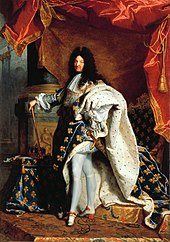

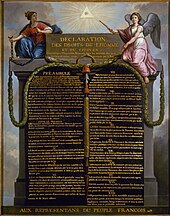
តំបន់ផលិតផលកសិកម្ម និងព្រៃឈើគ្របដណ្ដប់លើផ្ទៃដី៤៨លានហិកតា គឺស្មើនឹង៨២%នៃផ្ទៃដីគោក។ ព្រៃក្រាស់លាតសន្ធឹងលើ២៦%នៃផ្ទៃដីហើយជាប់ចំណាត់ថ្នាក់លេខ៣នៅអឺរ៉ុប បន្ទាប់ពី ស៊ុយអែដ និងហ្វាំងឡង់ ។ ផ្ទៃដីព្រៃឈើនៅប្រទេសបារាំងបានកើន៤៦%ចាប់តាំងពីឆ្នាំ១៩៤៥ ហើយនឹងកើនឡើងទ្វេដងក្នុងរយៈពេល២០០ឆ្នាំ។ លើលពីនេះ គេឃើញមាន ដើមឈើចំនួន១៣៦ប្រភេទផ្សេងគ្នានៅក្នុងប្រទេសបារាំង ដែលនេះគឺជាករណីពិសេសមួយសំរាប់ប្រទេសនៅក្នុងទ្វីបអឺរ៉ុប។
ចំនួនសត្វព្រៃមាន ការកើនឡើង ក្នុងរយៈពេលតែ២០ឆ្នាំ សត្វប្រើសមានចំនួនកើន ឡើងទ្វេ ដង រីឯពពួកសត្វឈ្លូសវិញកើនឡើងបីដង។
ដើម្បីថែរក្សា និងលើកតំកើងបេតិកភណ្ឌធម្មជាតិរបស់ប្រទេសបារាំង រដ្ឋបានបង្កើត ៖
- ឧទ្យានជាតិចំនួន៧
- តំបន់ការពារធម្មជាតិ១៥៦កន្លែង
- តំបន់ការពាររុក្ខជាតិ និងសត្វចំនួន៥១៦កន្លែង
- តំបន់រមណីដ្ឋាន ៤២៩កន្លែង ស្ថិតក្រោមការការពាររបស់ការិយាល័យការពារដែន សមុទ្រ
- រាប់បញ្ចូលផងដែរនូវឧទ្យានធម្មជាតិ៤៣កន្លែង។
នៅលើឆាកអន្ដរជាតិ ប្រទេសបារាំងជាភាគីនៃសន្ធិសញ្ញា និងអនុសញ្ញាជាច្រើនក្នុងនោះ មានទាំង អនុសញ្ញា អង្គការសហប្រជាជាតិស្ដីអំពីអា-កាសធាតុ ជីវៈចំរុះ និងការប្រែក្លាយ ជាតំបន់រហស្ថាន។
ប្រជាសាស្ត្រ
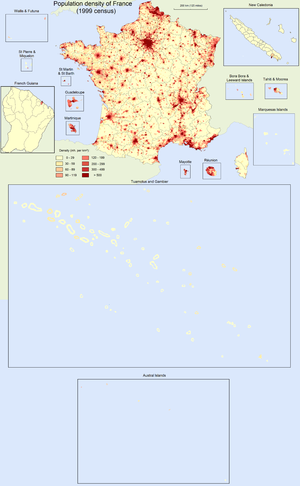
With an estimated population of 66 million people in July 2013, France is the 21st most populous country in the world.
In 2004, the Institut Montaigne estimated there were 51 million (85%) white people, 6 million (10%) North African people, 2 million (3.5%) black people and 1 million (1.5%) people of Asian origin in Metropolitan France.
In 2003, France's natural population growth (excluding immigration) was responsible for almost all natural population growth in the European Union. The natural growth rate (excess of births over deaths) rose to 300,000 in 2006, its highest since the end of the baby boom in 1973. The total fertility rate rose to 2 in 2010, from a nadir of 1.7 in 1994. From 2006 to 2011 population growth was on average +0.6% per year. In 2010, 27% of newborns in metropolitan France had at least one foreign-born parent and 24% had at least one parent born outside of Europe (parents born in overseas territories are considered as born in France).
In 2008, the French national institute of statistics INSEE estimated that 11.8 million foreign-born immigrants and their direct descendants (born in France) lived in France, representing 19% of the country's population. More than 5 million are of European origin and 4 million of Maghrebi origin. There are 2.7 million immigrants aged 18–50 (accounting for 10% of the population aged 18–50) and 5 million altogether (8% of the entire population). The second generation aged 18–50 make up 3.1 million (12% of 18–50) and 6.5 million for all ages (11% of population) In 2008, France granted citizenship to 137,000 persons, mostly to people from Morocco, Algeria and Turkey.
Although it is illegal for the French state to collect data on ethnicity and ancestry, a law with its origins in the 1789 revolution and reaffirmed in the French Constitution of 1958, some surveys, like the TeO ("Trajectories and origins") survey conducted jointly by INED and INSEE in 2008, are allowed to. Before this survey, it was estimated that 5 million people were of Italian ancestry (the most numerous immigrant community), between 3 million and 6 million people are of North African ancestry, 2.5 million people are of Sub-Saharan African ancestry, 200,000 people are of Turkish ancestry, and many more are of other European ethnic ancestry, such as Spaniards, Portuguese, Poles, and Greeks.
បច្ចុប្បន្ននេះ វាត្រូវបានគេប៉ាន់ប្រមាណថា 40% នៃប្រជាជនបារាំងត្រូវបានចុះមកយ៉ាងហោចណាស់មួយផ្នែកពីរលកផ្សេងគ្នានៃអន្តោប្រវេសន៍ដែលប្រទេសបានទទួល។ Between 1921 and 1935 about 1.1 million net immigrants came to France. An estimated 1.6 million pieds noirs returned to France as the country's North African possessions gained independence.
France accepts about 200,000 legal immigrants each year. France is the leading asylum destination in Western Europe with an estimated 50,000 applications in 2005 (a 15% decrease from 2004). The European Union allows free movement between the member states, France however put in place controls to curb Eastern European migration.
The largest cities in France, in terms of metropolitan area population, are Paris (11,836,970), Lyon (1,757,180), Marseille (1,618,369), Lille (1,163,934), Toulouse (1,118,472), Bordeaux (1,009,313), Nice (999,678), Nantes (768,305). A perennial political issue concerns rural flight.
Language

According to Article 2 of the Constitution, the official language of France is French, a Romance language derived from Latin. Since 1635, the Académie française has been France's official authority on the French language, although its recommendations carry no legal power.
រដ្ឋាភិបាលបារាំងមិនគ្រប់គ្រងជម្រើសនៃភាសាក្នុងការបោះពុម្ពដោយបុគ្គលនោះទេ ប៉ុន្តែការប្រើប្រាស់ភាសាបារាំងត្រូវបានទាមទារដោយច្បាប់ក្នុងការទំនាក់ទំនងពាណិជ្ជកម្ម និងកន្លែងធ្វើការ។ In addition to mandating the use of French in the territory of the Republic, the French government tries to promote French in the European Union and globally through institutions such as La Francophonie. The perceived threat from anglicisation has prompted efforts to safeguard the position of the French language in France. Besides French, there exist 77 vernacular minority languages of France, eight spoken in French metropolitan territory and 69 in the French overseas territories.
From the 17th to the mid-20th century, French served as the pre-eminent international language of diplomacy and international affairs as well as a lingua franca among the educated classes of Europe. The dominant position of French language in international affairs was overtaken by English, since the emergence of the US as a major power. Though for most of the time in which French served as an international lingua franca, it was not the native language of most Frenchmen: a report in 1794 conducted by Henri Grégoire found that of the country's 25 million people, only three million spoke French natively; the rest spoke one of the country's many regional languages, such as Alsatian, Breton or Occitan. Through the expansion of public education, in which French was the sole language of instruction, as well as other factors such as increased urbanization and the rise of mass communication, French gradually came to be adopted by virtually the entire population, a process not completed until the 20th century.
As a result of France's extensive colonial ambitions between the 17th and 20th centuries, French was introduced to America, Africa, Polynesia, South-East Asia, and the Caribbean. French is the second most studied foreign language in the world after English, and is a lingua franca in some regions, notably in Africa. The legacy of French as a living language outside Europe is mixed: it is nearly extinct in some former French colonies (South-east Asia), while creoles and pidgins based on French have emerged in the French departments in the West Indies and the South Pacific (French Polynesia). On the other hand, many former French colonies have adopted French as an official language, and the total number of French speakers is increasing, especially in Africa.
It is estimated that between 300 million and 500 million people worldwide can speak French, either as a mother tongue or a second language.
សាសនា
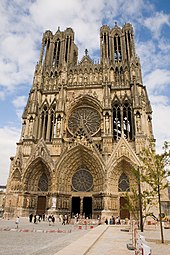
France is a secular country, and freedom of religion is a constitutional right. French religious policy is based on the concept of laïcité, a strict separation of church and state under which public life is kept completely secular.
Catholicism has been the predominant religion in France for more than a millennium, though it is not as actively practised today as it was. Among the 47,000 religious buildings in France, 94% are Roman Catholic. Whilst in 1965, 81% of the French declared themselves to be Catholics, in 2009 this proportion was 64%. Moreover, whilst 27% of the French went to Mass once a week or more in 1952, only 5% did so in 2006. The same survey found that Protestants accounted for 3% of the population, an increase from previous surveys, and 5% adhered to other religions, with the remaining 28% stating they had no religion. Evangelical Christianity may be the fastest growing religion in France.
The French Revolution saw a radical shift in the status of the Catholic Church with the launch of a brutal campaign of de-Christianization. After the back and forth of Catholic royal and secular republican governments over the 19th century, laïcité was established with the 1905 law on the Separation of the Churches and the State.
According to a poll in January 2007, only 5% of the French population attended church regularly (10% attend church services regularly among the respondents who did identify themselves as Catholics). The poll showed 51% identified as being Catholics, 31% identified as being agnostics or atheists (another poll sets the proportion of atheists equal to 27%), 10% identified as being from other religions or being without opinion, 4% identified as Muslim, 3% identified as Protestant, 1% identified as Buddhist, 1% identified as Jewish. Meanwhile, an independent estimate by the politologist Pierre Bréchon in 2009 concluded that the proportion of Catholics had fallen to 42% while the number of atheists and agnostics had risen to 50%.
Estimates of the number of Muslims in France vary widely. In 2003, the French Ministry of the Interior estimated the total number of people of Muslim background to be between 5 and 6 million (8–10%). According to the Pewforum, "In France, proponents of a 2004 law banning the wearing of religious symbols in schools say it protects Muslim girls from being forced to wear a headscarf, but the law also restricts those who want to wear headscarves – or any other “conspicuous” religious symbol, including large Christian crosses and Sikh turbans – as an expression of their faith"
The current Jewish community in France numbers around 600,000 according to the World Jewish Congress and is the largest in Europe.
Since 1905 the French government has followed the principle of laïcité, in which it is prohibited from recognising any specific right to a religious community (except for legacy statutes like that of military chaplains and the local law in Alsace-Moselle). Instead, it merely recognises religious organisations, according to formal legal criteria that do not address religious doctrine. Conversely, religious organizations should refrain from intervening in policy-making. Certain bodies of beliefs such as Scientology, Children of God, the Unification Church, or the Order of the Solar Temple are considered cults ("sectes" in French), and therefore do not have the same status as religions in France. Secte is considered a pejorative term in France.
សុខភាព

The French healthcare system was ranked first worldwide by the World Health Organization in 1997 and then again in 2000. Care is generally free for people affected by chronic diseases (affections de longues durées) such as cancer, AIDS or Cystic Fibrosis. Average life expectancy at birth is 78 years for men and 85 years for women, one of the highest of the European Union. There are 3.22 physicians for every 1000 inhabitants in France, and average health care spending per capita was US$4,719 in 2008. As of 2007, approximately 140,000 inhabitants (0.4%) of France are living with HIV/AIDS.
Even if the French have the reputation of being one of the thinnest peoples in developed countries, France—like other rich countries—faces an increasing and recent epidemic of obesity, due mostly to the replacement of traditional healthy French cuisine by junk food in French eating habits. Nevertheless, the French obesity rate is far below that of the USA (for instance, obesity rate in France is the same that the American once was in the 1970s), and is still the lowest of Europe, but it is now regarded by the authorities as one of the main public health issues and is fiercely fought; rates of childhood obesity are slowing in France, while continuing to grow in other countries.
ការអប់រំ
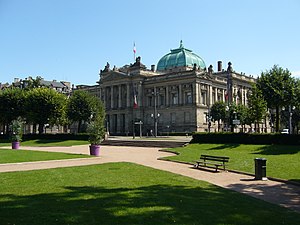
In 1802, Napoleon created the lycée. Nevertheless it is Jules Ferry who is considered to be the father of the French modern school, which is free, secular, and compulsory until the age of 13 since 1882 (school attendance in France is now compulsory until the age of 16).
Nowadays, the schooling system in France is centralized, and is composed of three stages, primary education, secondary education, and higher education. The Programme for International Student Assessment, coordinated by the OECD, currently ranks France's education as the 25th best in the world, being neither significantly higher nor lower than the OECD average. Primary and secondary education are predominantly public, run by the Ministry of National Education.
Higher education in France is divided between public universities and the prestigious and selective Grandes écoles, such as Science Po Paris for Political studies, HEC Paris for Economics, Polytechnique and the École nationale supérieure des mines de Paris that produces high-profile engineers, or the École nationale d'administration for careers in the great corps of the State. The Grandes écoles have been criticised for alleged elitism, nevertheless they have produced many if not most of France's high-ranking civil servants, CEOs, and politicians.
ប្រជាជន

មានប្រជាជនរស់នៅ៦៣,៨ លាននាក់ (២០០៨)។ ដង់សីតេប្រជាជន: ៩៨,១ នាក់/គម២។ទីក្រុងដែលមានប្រជាជនរស់នៅលើសពី ១០០ ០០០នាក់ មានចំនួន៥៧។ ក្នុងនោះមានទីក្រុង៥ ដែលមានប្រជាជន រស់នៅច្រើនជាងគេ ៖
| ទីក្រុង | ប្រជាជនក្នុងឆ្នាំ២០០៦ |
|---|---|
| 1. បារីស | ៩,៦ លាន |
| 2. លីល | ១,៧ លាន |
| 3. លីយ៉ុង | ១,៤ លាន |
| 4. ម៉ាកសី | ១,៣ លាន |
| 5. ទូលូ | ១ លាន |
Administrative divisions
France is divided into 27 administrative regions. 22 are in metropolitan France (21 are on the continental part of metropolitan France; one is the territorial collectivity of Corsica), and five are overseas regions. The regions are further subdivided into 101 departments which are numbered (mainly alphabetically). This number is used in postal codes and vehicle number plates amongst others.
The 101 departments are subdivided into 341 arrondissements which are, in turn, subdivided into 4,051 cantons. These cantons are then divided into 36,697 communes, which are municipalities with an elected municipal council. There are 2,588 intercommunal entities grouping 33,414 of the 36,697 communes (i.e. 91.1% of all the communes). Three communes, Paris, Lyon and Marseille are subdivided into 45 municipal arrondissements.
The regions, departments and communes are all known as territorial collectivities, meaning they possess local assemblies as well as an executive. Arrondissements and cantons are merely administrative divisions. However, this was not always the case. Until 1940, the arrondissements were territorial collectivities with an elected assembly, but these were suspended by the Vichy regime and definitely abolished by the Fourth Republic in 1946.
Metropolitan regions

| Region | Departments | រដ្ឋធានី |
|---|---|---|
 Alsace Alsace | Bas-Rhin, Haut-Rhin |  Strasbourg Strasbourg |
 Aquitaine Aquitaine | Dordogne, Gironde, Landes, Lot-et-Garonne, Pyrénées-Atlantiques |  Bordeaux Bordeaux |
 Auvergne Auvergne | Allier, Cantal, Haute-Loire, Puy-de-Dôme |  Clermont-Ferrand Clermont-Ferrand |
 Brittany Brittany | Côtes-d'Armor, Finistère, Ille-et-Vilaine, Morbihan |  Rennes Rennes |
 Burgundy Burgundy | Côte-d'Or, Nièvre, Saône-et-Loire, Yonne |  Dijon Dijon |
 Centre Centre | Cher, Eure-et-Loir, Indre, Indre-et-Loire, Loiret, Loir-et-Cher |  Orléans Orléans |
 Champagne-Ardenne Champagne-Ardenne | Ardennes, Aube, Haute-Marne, Marne |  Châlons-en-Champagne Châlons-en-Champagne |
 Corsica Corsica | Corse-du-Sud, Haute-Corse |  Ajaccio Ajaccio |
 Franche-Comté Franche-Comté | Doubs, Haute-Saône, Jura, Territoire de Belfort |  Besançon Besançon |
 Île-de-France Île-de-France | Essonne, Hauts-de-Seine, ប៉ារីស, Seine-et-Marne, Seine-Saint-Denis, Val-de-Marne, Val-d'Oise, Yvelines |  Paris Paris |
 Languedoc-Roussillon Languedoc-Roussillon | Aude, Gard, Hérault, Lozère, Pyrénées-Orientales |  Montpellier Montpellier |
 Limousin Limousin | Corrèze, Creuse, Haute-Vienne |  Limoges Limoges |
 Lorraine Lorraine | Meurthe-et-Moselle, Meuse, Moselle, Vosges |  Metz Metz |
 Lower Normandy Lower Normandy | Calvados, Manche, Orne |  Caen Caen |
 Midi-Pyrénées Midi-Pyrénées | Ariège, Aveyron, Gers, Haute-Garonne, Hautes-Pyrénées, Lot, Tarn, Tarn-et-Garonne |  Toulouse Toulouse |
 Nord-Pas-de-Calais Nord-Pas-de-Calais | Nord, Pas-de-Calais |  Lille Lille |
 Pays de la Loire Pays de la Loire | Loire-Atlantique, Maine-et-Loire, Mayenne, Sarthe, Vendée |  Nantes Nantes |
 Picardy Picardy | Aisne, Oise, Somme |  Amiens Amiens |
 Poitou-Charentes Poitou-Charentes | Charente, Charente-Maritime, Deux-Sèvres, Vienne |  Poitiers Poitiers |
 Provence-Alpes-Côte d'Azur Provence-Alpes-Côte d'Azur | Alpes-de-Haute-Provence, Alpes-Maritimes, Bouches-du-Rhône, Hautes-Alpes, Var, Vaucluse |  Marseille Marseille |
 Rhône-Alpes Rhône-Alpes | Ain, Ardèche, Drôme, Haute-Savoie, Isère, Loire, Rhône, Savoie |  Lyon Lyon |
 Upper Normandy Upper Normandy | Eure, Seine-Maritime |  Rouen Rouen |
Overseas regions
Among the 101 departments of France, five (French Guiana, Guadeloupe, Martinique, Mayotte, and Réunion) are in overseas regions (ROMs) that are also simultaneously overseas departments (DOMs) and are an integral part of France (and the European Union) and thus enjoy exactly the same status to metropolitan departments.
| Name | ស្ថានភាពរដ្ឋធម្មនុញ្ញ | រដ្ឋធានី |
|---|---|---|
| ទំព័រគំរូ:ទិន្នន័យប្រទេស French Guiana | Overseas region (régions d'outre-mer) and simultaneously overseas department (département d'outre-mer or DOM) | Cayenne |
 Guadeloupe Guadeloupe | Overseas region (régions d'outre-mer) and simultaneously overseas department (département d'outre-mer or DOM) | Basse-Terre |
| ទំព័រគំរូ:ទិន្នន័យប្រទេស Martinique | Overseas region (régions d'outre-mer) and simultaneously overseas department (département d'outre-mer or DOM) | Fort-de-France |
 Mayotte Mayotte | Overseas region (régions d'outre-mer) and simultaneously overseas department (département d'outre-mer or DOM) | Mamoudzou |
| ទំព័រគំរូ:ទិន្នន័យប្រទេស Réunion | Overseas region (régions d'outre-mer) and simultaneously overseas department (département d'outre-mer or DOM) | Saint-Denis |
Overseas territories and collectivities
In addition to the 27 regions and 101 departments, the French Republic has five overseas collectivities (French Polynesia, Saint Barthélemy, Saint Martin, Saint Pierre and Miquelon, and Wallis and Futuna), one sui generis collectivity (New Caledonia), one overseas territory (French Southern and Antarctic Lands), and one island possession in the Pacific Ocean (Clipperton Island).
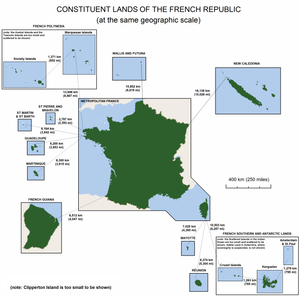
Overseas collectivities and territories form part of the French Republic, but do not form part of the European Union or its fiscal area (with the exception of St. Bartelemy, which seceded from Guadeloupe in 2007). The Pacific Collectivities (COMs) of French Polynesia, Wallis and Fortuna, and New Caledonia continue to use the CFP franc whose value is strictly linked to that of the euro. In contrast, the five overseas regions used the French franc and now use the euro.
| Name | ស្ថានភាពរដ្ឋធម្មនុញ្ញ | រដ្ឋធានី |
|---|---|---|
| ទំព័រគំរូ:ទិន្នន័យប្រទេស Clipperton Island | State private property under the direct authority of the French government | Uninhabited |
| ទំព័រគំរូ:ទិន្នន័យប្រទេស French Polynesia | Designated as an overseas land (pays d'outre-mer or POM), the status is the same as an overseas collectivity. | Papeete |
| ទំព័រគំរូ:ទិន្នន័យប្រទេស French Southern and Antarctic Lands | Overseas territory (territoire d'outre-mer or TOM) | Port-aux-Français |
 New Caledonia New Caledonia | Sui generis collectivity | Nouméa |
 Saint Barthélemy Saint Barthélemy | Overseas collectivity (collectivité d'outre-mer or COM) | Gustavia |
 Saint Martin Saint Martin | Overseas collectivity (collectivité d'outre-mer or COM) | Marigot |
| ទំព័រគំរូ:ទិន្នន័យប្រទេស Saint Pierre and Miquelon | Overseas collectivity (collectivité d'outre-mer or COM). Still referred to as a collectivité territoriale. | Saint-Pierre |
| ទំព័រគំរូ:ទិន្នន័យប្រទេស Wallis and Futuna | Overseas collectivity (collectivité d'outre-mer or COM). Still referred to as a territoire. | Mata-Utu |
ការគ្រប់គ្រងរដ្ឋបាល
ទឹកដីនៃសាធារណរដ្ឋបារាំងចែកជា ៖
- មេត្រូប៉ូល រួមមានទាំងអស់២២តំបន់ និង៩៦ខេត្ដ
- ខេត្ដឯនាយសមុទ្រចំនួន៤ (DOM) ហ្គាដឺឡុប ម៉ាកទីនិក ហ្គីយាន ឡារ៉េអ៊ុយនីញុង
- ដែនដីឯនាយសមុទ្រចំនួន៧: Polynésie française, Wallis et Futuna, Mayotte, Saint-Pierre និងMiquelon, les Terres australes និងantarctiques françaises, Saint-Barthélémy, Saint-Martin,
- និង La Nouvelle Calédonie.
Governance
Government
The French Republic is a unitary semi-presidential republic with strong democratic traditions. The constitution of the Fifth Republic was approved by referendum on 28 September 1958. It greatly strengthened the authority of the executive in relation to parliament. The executive branch itself has two leaders: the President of the Republic, currently François Hollande, who is head of state and is elected directly by universal adult suffrage for a 5-year term (formerly 7 years), and the Government, led by the president-appointed Prime Minister, currently Jean-Marc Ayrault.

The French parliament is a bicameral legislature comprising a National Assembly (Assemblée Nationale) and a Senate. The National Assembly deputies represent local constituencies and are directly elected for 5-year terms. The Assembly has the power to dismiss the cabinet, and thus the majority in the Assembly determines the choice of government. Senators are chosen by an electoral college for 6-year terms (originally 9-year terms), and one half of the seats are submitted to election every 3 years starting in September 2008.
The Senate's legislative powers are limited; in the event of disagreement between the two chambers, the National Assembly has the final say. The government has a strong influence in shaping the agenda of Parliament.
French politics are characterised by two politically opposed groupings: one left-wing, centred around the French Socialist Party, and the other right-wing, centred previously around the Rassemblement pour la République (RPR) and now its successor the Union for a Popular Movement (UMP). Since the 2012 elections, the executive branch is currently composed mostly of the Socialist Party.
ច្បាប់
France uses a civil legal system; that is, law arises primarily from written statutes; judges are not to make law, but merely to interpret it (though the amount of judicial interpretation in certain areas makes it equivalent to case law). Basic principles of the rule of law were laid in the Napoleonic Code (which was, in turn, largely based on the royal law codified under Louis XIV). In agreement with the principles of the Declaration of the Rights of Man and of the Citizen, law should only prohibit actions detrimental to society. As Guy Canivet, first president of the Court of Cassation, wrote about the management of prisons: Freedom is the rule, and its restriction is the exception; any restriction of Freedom must be provided for by Law and must follow the principles of necessity and proportionality. That is, Law should lay out prohibitions only if they are needed, and if the inconveniences caused by this restriction do not exceed the inconveniences that the prohibition is supposed to remedy.

French law is divided into two principal areas: private law and public law. Private law includes, in particular, civil law and criminal law. Public law includes, in particular, administrative law and constitutional law. However, in practical terms, French law comprises three principal areas of law: civil law, criminal law, and administrative law. Criminal laws can only address the future and not the past (criminal ex post facto laws are prohibited). While administrative law is often a subcategory of civil law in many countries, it is completely separated in France and each body of law is headed by a specific supreme court: ordinary courts (which handle criminal and civil litigation) are headed by the Court of Cassation and administrative courts are headed by the Council of State.
To be applicable, every law must be officially published in the Journal officiel de la République française.
France does not recognize religious law as a motivation for the enactment of prohibitions. France has long had neither blasphemy laws nor sodomy laws (the latter being abolished in 1791). However, "offenses against public decency" (contraires aux bonnes mœurs) or disturbing public order (trouble à l'ordre public) have been used to repress public expressions of homosexuality or street prostitution. Laws prohibiting discriminatory speech in the press are as old as 1881. Some consider however that hate speech laws in France are too broad or severe and damage freedom of speech.[ត្រូវការអំណះអំណាង] France has laws against racism and antisemitism.
France's attitude towards freedom of religion is complex. Freedom of religion is guaranteed by the constitutional rights set forth in the 1789 Declaration of the Rights of Man and of the Citizen. However, since the 1905 French law on the Separation of the Churches and the State, the State tries to prevent its policy-making from being influenced by religion and became suspicious in recent decades towards new religious tendencies of the French society: the Parliament has listed many religious movements as dangerous cults since 1995, and has banned wearing conspicuous religious symbols in schools since 2004. In 2010, it banned the wearing of face-covering Islamic veils in public. As some have complained that they have suffered from discrimination thus, and after criticism by human rights groups such as Amnesty International and Human Rights Watch, these laws remain controversial, although they are supported by most of the population.
France is tolerant of the LGBT community. Since 1999, civil unions for homosexual couples are permitted, and since May 2013, same-sex marriage and LGBT adoption are legal in France.
Foreign relations
France is a member of the United Nations and serves as one of the permanent members of the UN Security Council with veto rights. It is also a member of the G8, World Trade Organization (WTO), the Secretariat of the Pacific Community (SPC) and the Indian Ocean Commission (COI). It is an associate member of the Association of Caribbean States (ACS) and a leading member of the International Francophone Organisation (OIF) of fifty-one fully or partly French-speaking countries.


France hosts the headquarters of the OECD, UNESCO, Interpol, Alliance Base and the International Bureau for Weights and Measures. France has the second largest network of diplomatic missions in the world, second only to the USA. In 1953, France received a request from the United Nations to pick a coat of arms that would represent it internationally. Thus the French emblem was adopted and is currently used on passports.
Postwar French foreign policy has been largely shaped by membership of the European Union, of which it was a founding member. Since the 1960s, France has developed close ties with reunified Germany to become the most influential driving force of the EU. In the 1960s, France sought to exclude the British from the European unification process, seeking to build its own standing in continental Europe. However, since 1904, France has maintained an "Entente cordiale" with the United Kingdom, and there has been a strengthening of links between the countries, especially militarily.
France is a member of the North Atlantic Treaty Organisation (NATO), but under President de Gaulle, it excluded itself from the joint military command to protest the special relationship between the United States and Britain and to preserve the independence of French foreign and security policies. France vigorously opposed the 2003 invasion of Iraq, straining bilateral relations with the US and the UK. However, as a result of Nicolas Sarkozy's pro-American politics (much criticised in France by the leftists and by a part of the right), France rejoined the NATO joint military command on 4 April 2009.
In the early 1990s, the country drew considerable criticism from other nations for its underground nuclear tests in French Polynesia.
France retains strong political and economic influence in its former African colonies (Françafrique) and has supplied economic aid and troops for peace-keeping missions in Ivory Coast and Chad. Recently, after the unilateral declaration of independence of northern Mali by the Tuareg MNLA and the subsequent regional Northern Mali conflict with several Islamist groups including Ansar Dine and MOJWA, France and other African states intervened to help the Malian Army to retake control.
In 2009, France was the second largest (in absolute numbers) donor of development aid in the world, behind the US, and ahead of Germany, Japan and the UK. This represents 0.5% of its GDP, in this regard rating France as tenth largest donor on the list. The organisation managing the French help is the French Development Agency, which finances primarily humanitarian projects in sub-Saharan Africa. The main goals of this help are "developing infrastructure, access to health care and education, the implementation of appropriate economic policies and the consolidation of the rule of law and democracy."
Military
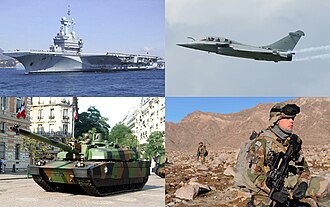
The French Armed Forces (Armées françaises) are the military and paramilitary forces of France, under the president as supreme commander. They consist of the French Army (Armée de Terre), French Navy (Marine Nationale), the French Air Force (Armée de l'Air) and the auxiliary paramilitary force, the National Gendarmerie (Gendarmerie nationale) and are among the largest armed forces in the world. While administratively a part of the French armed forces, and therefore under the purview of the Ministry of Defence, the Gendarmerie is operationally attached to the Ministry of the Interior.
The gendarmerie is a military police force which serves for the most part as a rural and general purpose police force. It encompasses the counter terrorist units of the Parachute Intervention Squadron of the National Gendarmerie (Escadron Parachutiste d'Intervention de la Gendarmerie Nationale) and the National Gendarmerie Intervention Group (Groupe d'Intervention de la Gendarmerie Nationale). One of the French intelligence units, the Directorate-General for External Security (Direction Générale de la Sécurité Extérieure) reports to the Ministry of Defence. The other, the Central Directorate of Interior Intelligence (Direction Centrale du Renseignement Intérieur), reports directly to the Ministry of the Interior. There has been no national conscription since 1997.
France is a permanent member of the Security Council of the UN, and a recognised nuclear state since 1960. France has signed and ratified the Comprehensive Nuclear-Test-Ban Treaty (CTBT) and acceeded to the Nuclear Non-Proliferation Treaty. France's annual military expenditure in 2011 was US$62.5 billion, or 2.3%, of its GDP making it the fifth biggest military spender in the world after the United States, China, Russia, and the United Kingdom.
French nuclear deterrence, (formerly known as “Force de Frappe”), relies on complete independence. The current French nuclear force consists of four Triomphant class submarines equipped with submarine-launched ballistic missiles. In addition to the submarine fleet, it is estimated that France has about 60 ASMP medium-range air-to-ground missiles with nuclear warheads, of which around 50 are deployed by the Air Force using the Mirage 2000N long-range nuclear strike aircraft, while around 10 are deployed by the French Navy's Super Étendard Modernisé (SEM) attack aircraft which operate from the nuclear-powered aircraft carrier Charles de Gaulle. The new Rafale F3 aircraft will gradually replace all Mirage 2000N and SEM in the nuclear strike role with the improved ASMP-A missile with a nuclear warhead.
France has major military industries with one of the largest aerospace industries in the world. Its industries have produced such equipment as the Rafale fighter, the Charles de Gaulle aircraft carrier, the Exocet missile and the Leclerc tank amongst others. Despite withdrawing from the Eurofighter project, France is actively investing in European joint projects such as the Eurocopter Tiger, multipurpose frigates, the UCAV demonstrator nEUROn and the Airbus A400M. France is a major arms seller, with most of its arsenal's designs available for the export market with the notable exception of nuclear-powered devices.
The military parade held in Paris each 14 July for France's national day is the oldest and largest regular military parade in Europe.
ហិរញ្ញវត្ថុរបស់រដ្ឋាភិបាល

In April and May 2012, France held a presidential election in which the winner, François Hollande, had opposed austerity measures, promising to eliminate France's budget deficit by 2017. The new government stated that it aimed to cancel recently enacted tax cuts and exemptions for the wealthy, raising the top tax bracket rate to 75% on incomes over a million euros, restoring the retirement age to 60 with a full pension for those who have worked 42 years, restoring 60,000 jobs recently cut from public education, regulating rent increases; and building additional public housing for the poor.
In June, Hollande's Socialist Party won a supermajority in legislative elections capable of amending the French Constitution and enabling the immediate enactment of the promised reforms. French government bond interest rates fell 30% to record lows, less than 50 basis points above German government bond rates.
បំណុលរដ្ឋាភិបាល
Under European Union rules, member states are supposed to limit their debt to 60% of output or be reducing the ratio structurally towards this ceiling, and run public deficits of no more than 3% of GDP. The French government has run a budget deficit each year since the early 1970s. In 2012, French government debt levels reached 1.8 trillion euros, the equivalent of 90% of French GDP.
In late 2012, credit rating agencies warned that growing French government debt levels risked France's AAA credit rating, raising the possibility of a future downgrade and subsequent higher borrowing costs for the French government.
ស្ថាប័ននានារបស់បារាំង
រដ្ឋធម្មនុញ្ញ
រដ្ឋធម្មនុញ្ញថ្ងៃទី ៤ តុលា ឆ្នាំ១៩៥៨ ចែងពីដំណើរការស្ថាប័ននានានៃសាធារណរដ្ឋទី៥។
រដ្ឋធម្មនុញ្ញត្រូវបានគេសើរើ ពិនិត្យឡើងវិញជាច្រើនដងទាក់ទងនឹង ៖
- ការបោះឆ្នោតប្រធានាធិបតីជាសកល និងដោយចំពោះ (១៩៦២)
- ការដាក់បញ្ចូលជំពូកថ្មីមួួយស្ដីការទទួលខុសត្រូវខាងព្រហ្មទណ្ឌរបស់សមាជិករដ្ឋាភិបាល(១៩៩៣)
- ការបង្កើតសម័យប្រជុំរួមមួយរវាងស្ថាប័នសភា
- ការពង្រីកដែនធ្វើប្រជាមតិ(១៩៩៥)
- អន្ដរបញ្ញត្ដិស្ដីពីលក្ខន្ដិកៈរបស់កោះណូវែលកាលេដូនី ( Nouvelle-Calédonie ) (១៩៩៨)
- ការបង្កើតសហព័ន្ធសេដ្ឋកិច្ចនិងរូបិយវត្ថុ
- ភាពស្មើគ្នារវាងបុរសនិងស្ដ្រីនៅក្នុងការទទួលអណត្ដិបោះឆ្នោតនានា និងទទួលនូវដែលគេជ្រើសរើស
- ការទទួលស្គាល់យុត្ដាធិការនៃតុលាការព្រហ្មទណ្ឌអន្ដរជាតិ(១៩៩៩)
- ការកាត់បន្ថយអាណត្ដិប្រធានាធិបតី(២០០០)
- កែទំរង់ការទទួលខុសត្រូវខាងព្រហ្មទណ្ឌរបស់ប្រមុខរដ្ឋ
- បញ្ចូលការហាមឃាត់់ទោសប្រហារជីវិតក្នុងរដ្ឋធម្មនុញ្ញ
- កំណែទំរង់ភាពស្វយ័តរបស់កោះណូវែលកាឡេដូនី(២០០៧)
ក្រុមប្រឹក្សាធម្មនុញ្ញ


ក្រុមប្រឹក្សាធម្មនុញ្ញមានសមាជិក៩រូប និងមានសមត្ថកិច្ចត្រួតពិនិត្យជាពិសេសនៃ ភាពត្រឹម ត្រូវ តាមច្បាប់ នៃការបោះឆ្នោតនានា និងពិនិត្យធម្មនុញ្ញភាពនៃច្បាប់រៀបចំអង្គការ ព្រម ទាំងច្បាប់ ដែលដាក់មកអនុម័ត។
ប្រធានាធិបតីនៃសារធារណរដ្ឋ
ប្រមុខរដ្ឋត្រូវបានជ្រើសរើសសំរាប់រយៈពេល៥ឆ្នាំតាមរយៈការបោះឆ្នោតជាសកល និង ដោយចំពោះ (អណត្ដិរយៈពេល៥ឆ្នាំនេះបានបង្កើតឡើងបន្ទាប់ពីការធ្វើប្រជាមតិនៅថ្ងៃទី ២៤ ខែកញ្ញា ឆ្នាំ២០០០)។ លោក នីកូឡា សាកូហ្ស៊ី ជាប្រធានាធិបតីទី៦នៃសាធារណរដ្ឋ ទី៥ លោកបានជាប់ឆ្នោតនៅថ្ងៃទី៧ឧសភា ឆ្នាំ២០០៧ ។
ប្រធានាធិបតីតែងតាំងនាយករដ្ឋមន្ដ្រី និងសមាជិករដ្ឋាភិបាលតាមសំណើររបស់នាយក រដ្ឋមន្ដ្រី (មាត្រា ទី៨នៃរដ្ឋធម្មនុញ្ញ)។
ប្រធានាធិបតីដឹកនាំគណៈរដ្ឋមន្ដ្រី ប្រកាសអោយប្រើច្បាប់នានា ជាបញ្ជាការនៃកងកម្លាំង ប្រដាប់អាវុធ។ ប្រធានាធិបតីអាចរំលាយរដ្ឋសភា ហើយក្នុងករណីធ្ងន់ធ្ងរ ប្រធានាធិបតីមានអំណាចពិសេស (មាត្រាទី១៦)។
នាយករដ្ឋមន្ដ្រី និងរដ្ឋាភិបាល
ក្រោមការដឹកនាំរបស់នាយករដ្ឋមន្ដ្រី រដ្ឋាភិបាលកំណត់ និងដឹកនាំនយោបាយជាតិ។ នាយករដ្ឋមន្ដ្រី ទទួល ខុសត្រូវចំពោះរដ្ឋសភា (មាត្រាទី២០)។ នាយករដ្ឋមន្ដ្រីដឹកនាំសកម្មភាពរដ្ឋាភិបាលនិងធានានូវការអនុវត្ដច្បាប់ (មាត្រាទី២១)។ លោក François Fillon ត្រូវ បានតែងតាំងជានាយក រដ្ឋមន្ដ្រីនៅថ្ងៃទី១៧ ឧសភា ឆ្នាំ២០០៧។
សភា
សភាមានពីរថ្នាក់ ៖
- ព្រឹទ្ធសភា ៖ ព្រឹទ្ធសមាជិកត្រូវជ្រើសតាំងសំរាប់រយៈពេល៦ឆ្នាំ(ពីមុនមានរយៈពេល៩ឆ្នាំ) ចាប់តាំងពីឆ្នាំ ២០០៣ ដោយការបោះឆ្នោតជាសកល និងមិនចំពោះ ហើយត្រូវបានផ្លាស់ ប្ដូរសមាជិក ៣០% ក្នុងរយៈ ពេលបីឆ្នាំម្ដង។ ការបោះឆ្នោតលើកចុងក្រោយ បានប្រព្រឹត្ដ ទៅនៅខែ កញ្ញាឆ្នាំ២០០៤។
- រដ្ឋភាជាតិ ៖ តំណាងរាស្ដ្រត្រូវបានជ្រើសតាំងសំរាប់រយៈពេល៥ឆ្នាំដោយការបោះឆ្នោត ជាសកល និង ដោយចំពោះ។ ការបោះឆ្នោតលើកចុងក្រោយបាន ប្រព្រឹត្ដទៅនៅខែមិថុ- នា ឆ្នាំ២០០៧។
ក្រៅពីត្រួតពិនិត្យរដ្ឋាភិបាល សភាទាំងពីរថ្នាក់មានតួនាទីរៀបចំ និងអនុម័តច្បាប់។ ក្នុងករណីមិនមានការយល់ព្រម រដ្ឋសភាជាតិធ្វើការសំរេចជាស្ថាពរ។
ព្រឹទ្ធសភា
ក្រោយការបោះឆ្នោតខែកញ្ញឆ្នាំ២០០៤ ព្រឹទ្ធសភាមានសមាជិក៣៣១នាក់ដែលមកពី ៖
- គណបក្សសហព័ន្ធសំរាប់ចលនាប្រជាជន ( UMP ) ៖ ១៥៨នាក់
- គណបក្សសង្គមនិយម ៖ ៩៦នាក់
- ក្រុមគណបក្សកណ្ដាលនិយម ៖ ៣០នាក់
- គណបក្សកុម្មុយនិស្ដ គណបក្សសាធារណរដ្ឋ និងគណបក្សពលរដ្ឋ ៖ ២៣នាក់
- គណបក្សសម្ព័ន្ធភាពប្រជាធិបតី និងសង្គមអឺរ៉ុប ៖១៦នាក់
- បេក្ខជនឯករាជ្យ ៖ ៦នាក់ ។
រដ្ឋសភាជាតិ

បន្ទាប់ពីការបោះឆ្នោតថ្ងៃទី១០ និង១៧ឆ្នាំ២០០៧មិថុនា រដ្ឋសភាជាតិមានតំណាងរាស្ដ្រ៥៧៧នាក់ មកពី ៖
- គណបក្សសហព័ន្ធសំរាប់ចលនាប្រជាជន (UMP) ៖ ៣១៤នាក់ (សម្ព័ន្ធភាព៦គណបក្ស)
- ក្រុមសង្គមនិយម និងប្រជាជនៈ ១៨៦នាក់(សម្ព័ន្ធ១៨គណបក្ស)
- ក្រុមប្រជាធិបតីឆ្វេងនិយម និងសាធារណរដ្ឋ ៖ ២៤នាក់ (គ្មានសម្ព័ន្ធភាព)
- ក្រុមគណបក្សកណ្ដាលនិយមថ្មី ៖ ២០នាក់(សម្ព័ន្ធភាព២គណបក្ស)
- តំណាងរាស្ដ្រមិនស្ថិតក្នុងក្រុមណាមួយ ៖ ២០នាក់
តុលាការ
តុលាការជាអ្នកការពារសេរីភាពបុគ្គល (មាត្រា៦៦នៃ រដ្ឋធម្មនុញ្ញ)។ អំណាចតុលាការបា- រាំងបានរៀបចំ ទៅតាមភាពខុសគ្នាជាមូលដ្ឋានរវាង ៖
- តុលាការយុត្ដិធម៌ត្រូវទទួលខុសត្រូវជំលោះរវាងបុគ្គល និងបុគ្គល។
- តុលាការរដ្ឋបាលដោះស្រាយជំលោះរវាងប្រជាជននិងអំណាចសាធារណៈ។
តុលាការមានពីរលំដាប់ថ្នាក់ ៖
1. យុត្ដាធិការរដ្ឋប្បវេណី តុលាការនីតិរួម (តុលាការជាន់ខ្ពស់) រឺនីតិពិសេសផ្សេងៗ (សាលាតំបូង តុលាការពាណិជ្ជ កម្ម តុលាការកិច្ចការសន្ដិសុខសង្គម និងក្រុមតុលាការការងារដែលដោះស្រាយជំលោះ រវាងបុគ្គលិក និយោជិក និងនិយោជក។
2. យុត្ដិធិការព្រហ្មទណ្ឌទទួលបន្ទុកវិនិច្ឆ័យលើបទល្មើស៣ប្រភេទ ៖
- បទលហុដែលវិនិច្ឆ័យដោយតុលាការនគរបាល
- បទល្មើសដែលវិនិច្ឆ័យដោយតុលាការលហុ
- បទឧក្រិដ្ឋដោយសាលាឧក្រិដ្ឋ
មានតុលាការដោយឡែកសំរាប់រដ្ឋប្បវេណី និងព្រហ្មទណ្ឌតុលាការកុមារ។
សាលាវិនិច្ឆ័យ ៖គឺជាតុលាខ្ពស់ជាងគេ ហើយទទួលខុសត្រូវពិនិត្យបណ្ដឹងសារទុក្ខលើអង្គច្បាប់ប្រឆាំងនឹងសាលដីការបស់សាលាឧទ្ធរណ៍។យុត្ដាធិការខ្ពស់ជាងគេក្នុងតុលាការរដ្ឋបាលគឺក្រុមប្រឹក្សារដ្ឋដែលមានសមត្ថកិច្ចធ្វើការវិនិច្ឆ័យចុងក្រោយ គេបង្អស់លើភាពត្រឹមត្រូវនៃលិខិតរដ្ឋបាលតាមច្បាប់។ ក្រុមប្រឹក្សារដ្ឋនេះក៏ផ្ដល់ការពិគ្រោះផងដែរដល់រដ្ឋាភិបាលក្នុងការផ្ដល់ជាគំនិតស្ដីពីសេចក្ដី ព្រាងច្បាប់និង សេចក្ដីព្រាងក្រឹត្យមួយចំនួន។
ភ្លេង និងបាវចនាជាតិ
thumb|right|La Defense



បទចំរៀងសំរាប់កងទ័ពនៅទីក្រុង Rhin ដែលត្រូវបានតែងឡើងនៅទីក្រុងស្ដ្រាសបួ ឆ្នាំ ១៧៩២ បានក្លាយជាបទ Marseillaise ហើយចុងបញ្ចប់់ត្រូវបាន ប្រើជាភ្លេងជាតិនៅ ថ្ងៃទី១៤ កក្កដា ឆ្នាំ១៧៩៥។
បាវវចនារបស់សាធារណៈរដ្ឋបារាំងគឺ “សេរីភាព សមភាព ភាតរភាព“។
ទង់ជាតិបារាំង
នៅឆ្នាំ១៧៨៩ លោកឧត្ដមសេនីយ Fayette បាន បន្ថែមពណ៌សដែលជានិមិត្ដរូបនៃរាជា និយម ទៅលើ សញ្ញាទង់ជាតិដែលមានពណ៌ខៀវ និង ពណ៌ក្រហម របស់កងទ័ពជាតិទីក្រុង ប៉ារីស ។ ទង់ជាតិបីពណ៌ជា និមិត្ដរូបផ្លូវការរបស់ សាធារណរដ្ឋបារាំង។
ការពារជាតិ
នៅឆ្នាំ២០០៧ ថវិកាការពារជាតិឡើងដល់ ៣៦,២៥ពាន់លានអឺរ៉ូ គឹស្មើនឹង២,០២%នៃ ផលិតផល ក្នុងស្រុកសរុប និងថវិកាជាតិ១០,៨២%។
ច្បាប់ស្ដីពីការរៀបចំកម្មវិធីផ្នែកយោធាឆ្នាំ២០០៣-២០០៨កំនត់ពីមធ្យោបាយ និងចំនួនទ័ព ដើម្បី ឆានាទៅ សំរេចគោលបំណងរបស់ប្រធានាធិបតី និងរដ្ឋាភិបាលក្នុងការផ្ដល់អោយ ប្រទេសបារាំងការ ការពារមួយ ដោយស្របទៅតាមតំរូវការរបស់ខ្លួន។ច្បាប់នេះមានគោលដៅបង្កើតកិច្ចខំប្រឹងប្រែងក្នុងការធ្វើអោយឧបករណ៍ការពារជាតិ របស់យើងអាចឆ្លើយ តបទៅនឹងបញ្ហាចំពោះមុខនានា។
កិច្ចខំប្រឹងប្រែងខាងលើស្ដែងអោយឃើញតាមរយៈ ៖
- ការពង្រឹងមធ្យោបាយប្រយុទ្ធប្រឆាំង នឹងភេវរកម្ម។
- សុវត្ថិភាព និងភាពទុកចិត្ដនៃការទប់ស្កាត់អាវុធនុយក្លេអ៊ែររបស់ប្រទេសបារាំង។
- ការចូលរួមរបស់ប្រទេសបារាំងក្នុងការបង្ការ និងដោះស្រាយជលោះផ្សេងៗ (ចំនួនទ័ព ប្រមាណពី១៥ ទៅ២០ ០០០នាក់ត្រូវបានដាក់ពង្រាយក្នុងប្រតិបត្ដិការ )។
- សហប្រតិបត្ដិការយោធាក្នុងអង្គការអូតង់ និងសហគមអឺរ៉ុប។
នៅឆ្នាំ២០០៦ ទ័ពកងកំលាំងប្រដាប់អាវុធកើនឡើងដល់៣៤៧ ៩០៣នាក់ គិតទាំងយោធា និងជន ស៊ីវិល ហើយបែងចែកដូចខាងក្រោម ៖
- កងទ័ពជើងគោកមាន ១៣៣ ៦២៧នាក់
- កងទ័ពអាកាសមាន ៥៩ ១១៨នាក់
- កងទ័ពជើងទឹកមាន ៤២ ៧៥២នាក់
- កងអាវុធហត្ថមាន ៩៧ ៧២៣នាក់
- ក្នុងសេវាសាធារណៈ (សុខភាព ការងារសង្គមកិច្ច)មាន១៤ ៦៨៣នាក់
សេដ្ឋកិច្ច
បារាំងជាប្រទេសមានអនុភាពសេដ្ឋកិច្ចពិភពលោកលំដាប់ទី៦បន្ទាប់ពី សហរដ្ឋអាមេរិក ជប៉ុន អាលឺម៉ង់ ចិន និង អង់គ្លេស។
A member of the G8 group of leading industrialised countries, it is ranked as the world's seventh largest and the EU's second largest economy by purchasing power parity. With 39 of the 500 biggest companies in the world in 2010, France ranks fourth in the Fortune Global 500, ahead of Germany and the UK. France joined 11 other EU members to launch the euro in 1999, with euro coins and banknotes completely replacing the French franc (₣) in 2002.

France has a mixed economy which combines extensive private enterprise with substantial state enterprise and government intervention. The government retains considerable influence over key segments of infrastructure sectors, with majority ownership of railway, electricity, aircraft, nuclear power and telecommunications. It has been relaxing its control over these sectors since the early 1990s. The government is slowly corporatising the state sector and selling off holdings in France Télécom, Air France, as well as in the insurance, banking, and defence industries. France has an important aerospace industry led by the European consortium Airbus, and has its own national spaceport, the Centre Spatial Guyanais.

According to the World Trade Organization (WTO), in 2009 France was the world's sixth largest exporter and the fourth largest importer of manufactured goods. In 2008, France was the third largest recipient of foreign direct investment among OECD countries at $118 billion, ranking behind Luxembourg (where foreign direct investment was essentially monetary transfers to banks located there) and the US ($316 billion), but above the UK ($96.9 billion), Germany ($25 billion), or Japan ($24 billion).
In the same year, French companies invested $220 billion outside France, ranking France as the second largest outward direct investor in the OECD, behind the US ($311 billion), and ahead of the UK ($111 billion), Japan ($128 billion) and Germany ($157 billion).
Financial services, banking and the insurance sector are an important part of the economy. The Paris stock exchange (បារាំង: La Bourse de Paris) is an old institution, created by Louis XV in 1724. In 2000, the stock exchanges of Paris, Amsterdam and Bruxelles merged into Euronext. In 2007, Euronext merged with the New York stock exchange to form NYSE Euronext, the world's largest stock exchange. Euronext Paris, the French branch of the NYSE Euronext group is Europe's 2nd largest stock exchange market, behind the London Stock Exchange.
French companies have maintained key positions in the insurance and banking industries: AXA is the world's largest insurance company. The leading French banks are BNP Paribas and the Crédit Agricole, ranking as the world's first and sixth largest banks in 2010 (by assets), while the Société Générale group was ranked the world's eighth largest in 2009.
France is the smallest emitter of carbon dioxide among the G8, due to its heavy investment in nuclear power. As a result of large investments in nuclear technology, most electricity produced by France is generated by 59 nuclear power plants (75% in 2012). In this context, renewable energies are having difficulty taking off.
Agriculture

France has historically been a large producer of agricultural products. Large tracts of fertile land, the application of modern technology, and EU subsidies have combined to make France the leading agricultural producer and exporter in Europe (representing 20% of the EU's agricultural production) and the world's third biggest exporter of agricultural products.
Wheat, poultry, dairy, beef, and pork, as well as internationally recognized processed foods are the primary French agricultural exports. Rosé wines are primarily consumed within the country, but champagne and Bordeaux wines are major exports, being known worldwide. EU agriculture subsidies to France have decreased in recent years, but still amounted to $8 billion in 2007. That same year, France sold 33.4 billion euros of transformed agricultural products.
Agriculture is thus an important sector of France's economy: 3.8% of the active population is employed in agriculture, whereas the total agri-food industry made up 4.2% of French GDP in 2005.
Labour market
French GDP per capita is similar to comparable European countries such as Germany and the UK. GDP per capita is determined by (i) productivity per hour worked, (ii) the number of hours worked, which is one of the lowest of developed countries, and (iii) the employment rate.
France has one of the lowest 15–64 years employment rates of the OECD countries: in 2012, only 71% of the French population aged 15–64 years were in employment, compared to 74% in Japan, 77% in the UK, 73% in the US and 77% in Germany. This gap is due to the low employment rate for 15–24 years old: 38% in 2012, compared to 47% in the OECD. This low rate is explained by the high minimum wages which prevent low productivity workers – such as young people – from easily entering the labour market, ineffective university curricula that fail to prepare students adequately for the labour market. It has been argued that French laws that protect full-time workers have the effect of trapping highly educated youth into temporary and informal employment, because of the difficulty and expense of dealing with formal full-time employees.
In July 2013, the unemployment rate for France was 11%. Shorter working hours and the reluctance to reform the labour market are mentioned as weak spots of the French economy in the view of right-wing commentators, whilst the left claims lack of government policies fostering social justice. Liberal economists have stated repeatedly that the main problem in the French economy is the issue of structural reforms, in order to increase the size of the working population in the overall population, reduce the taxation level and the administrative burden.
Keynesian economists have different answers to the unemployment issue, and their theories led to the 35-hour workweek law in the 2000s (decade), which turned out to be a failure in reducing unemployment. Afterwards, between 2004 and 2008, the government made some supply-side reforms to combat unemployment but met with fierce resistance, especially with the contrat nouvelle embauche and the contrat première embauche which both were eventually repealed. The Sarkozy government used the revenu de solidarité active to redress the negative effect of the revenu minimum d'insertion on the incentive to work.
ទេសចរណ៍

With 83 million foreign tourists in 2012, France is ranked as the first tourist destination in the world, ahead of the US (67 million) and China (58 million). This 83 million figure excludes people staying less than 24 hours, such as North Europeans crossing France on their way to Spain or Italy. It is third in income from tourism due to shorter duration of visits.

France has 37 sites inscribed in UNESCO's World Heritage List and features cities of high cultural interest, beaches and seaside resorts, ski resorts, and rural regions that many enjoy for their beauty and tranquillity (green tourism). Small and picturesque French villages are promoted through the association Les Plus Beaux Villages de France (litt. "The Most Beautiful Villages of France").
The "Remarkable Gardens" label is a list of the over 200 gardens classified by the French Ministry of Culture. This label is intended to protect and promote remarkable gardens and parks. France attracts many religious pilgrims on their way to St. James, or to Lourdes, a town in the Hautes-Pyrénées that hosts several million visitors a year.
France, especially Paris, has some of the world's largest and renowned museums, including the Louvre, which is the most visited art museum in the world, the Musée d'Orsay, mostly devoted to impressionism, and Beaubourg, dedicated to Contemporary art.

Disneyland Paris is Europe's most popular theme park, with 15 million combined visitors to the resort's Disneyland Park and Walt Disney Studios Park in 2009.
With more than 10 millions tourists a year, the French Riviera (or Côte d'Azur), in south-east France, is the second leading tourist destination in the country, after the Paris region. It benefits from 300 days of sunshine per year, 115 kiloម៉ែត្រs (71 mi) of coastline and beaches, 18 golf courses, 14 ski resorts and 3,000 restaurants. Each year the Côte d'Azur hosts 50% of the world's superyacht fleet.
Another major destination are the Châteaux of the Loire Valley, this World Heritage Site is noteworthy for its architectural heritage, in its historic towns but in particular its castles (châteaux), such as the Châteaux d'Amboise, de Chambord, d'Ussé, de Villandry and Chenonceau.
The most popular tourist sites include: (according to a 2003 ranking visitors per year): Eiffel Tower (6.2 million), Louvre Museum (5.7 million), Palace of Versailles (2.8 million), Musée d'Orsay (2.1 million), Arc de Triomphe (1.2 million), Centre Pompidou (1.2 million), Mont Saint-Michel (1 million), Château de Chambord (711,000), Sainte-Chapelle (683,000), Château du Haut-Kœnigsbourg (549,000), Puy de Dôme (500,000), Musée Picasso (441,000), Carcassonne (362,000).
Transport
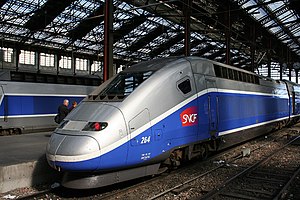
The railway network of France, which as of 2008[update] stretches 29,473 kiloម៉ែត្រs (18,314 mi) is the second most extensive in Western Europe after the German one. It is operated by the SNCF, and high-speed trains include the Thalys, the Eurostar and TGV, which travels at 320 km/h (199 mph) in commercial use. The Eurostar, along with the Eurotunnel Shuttle, connects with the United Kingdom through the Channel Tunnel. Rail connections exist to all other neighbouring countries in Europe, except Andorra. Intra-urban connections are also well developed with both underground services and tramway services complementing bus services.
There are approximately 1,027,183 kiloម៉ែត្រs (638,262 mi) of serviceable roadway in France, ranking it the most extensive network of the European continent. The Paris region is enveloped with the most dense network of roads and highways that connect it with virtually all parts of the country. French roads also handle substantial international traffic, connecting with cities in neighbouring Belgium, Spain, Andorra, Monaco, Switzerland, Germany and Italy. There is no annual registration fee or road tax; however, motorway usage is through tolls except in the vicinity of large communes. The new car market is dominated by domestic brands such as Renault (27% of cars sold in France in 2003), Peugeot (20.1%) and Citroën (13.5%). Over 70% of new cars sold in 2004 had diesel engines, far more than contained petrol or LPG engines. France possesses the Millau Viaduct, the world's tallest bridge, and has built many important bridges such as the Pont de Normandie.
There are 475 airports in France. Charles de Gaulle Airport, located in the vicinity of Paris, is the largest and busiest airport in the country, handling the vast majority of popular and commercial traffic and connecting Paris with virtually all major cities across the world. Air France is the national carrier airline, although numerous private airline companies provide domestic and international travel services. There are ten major ports in France, the largest of which is in Marseille, which also is the largest bordering the Mediterranean Sea. 12,261 kiloម៉ែត្រs (7,619 mi) of waterways traverse France including the Canal du Midi which connects the Mediterranean Sea to the Atlantic Ocean through the Garonne river.
វប្បធម៌
ប្រទេសបារាំងគឺជាមជ្ឈមណ្ឌលនៃការអភិវឌ្ឍន៍វប្បធម៌លោកខាងលិចអស់ជាច្រើនសតវត្សមកហើយ។ វិចិត្រករបារាំងជាច្រើនបានស្ថិតក្នុងចំណោមអ្នកល្បីល្បាញបំផុតនៃសម័យកាលរបស់ពួកគេ ហើយប្រទេសបារាំងនៅតែត្រូវបានទទួលស្គាល់នៅលើពិភពលោកសម្រាប់ប្រពៃណីវប្បធម៌ដ៏សម្បូរបែបរបស់វា។
The successive political regimes have always promoted artistic creation, and the creation of the Ministry of Culture in 1959 helped preserve the cultural heritage of the country and make it available to the public. The Ministry of Culture has been very active since its creation, granting subsidies to artists, promoting French culture in the world, supporting festivals and cultural events, protecting historical monuments. The French government also succeeded in maintaining a cultural exception to defend audiovisual products made in the country.
France receives the highest number of tourists per year, largely thanks to the numerous cultural establishments and historical buildings implanted all over the territory. It counts 1,200 museums welcoming more than 50 million people annually. The most important cultural sites are run by the government, for instance through the public agency Centre des monuments nationaux, which is responsible for approximately 85 national historical monuments.
The 43,180 buildings protected as historical monuments include mainly residences (many castles, or châteaux in French) and religious buildings (cathedrals, basilicas, churches, etc.), but also statutes, memorials and gardens. The UNESCO inscribed 38 sites in France on the World Heritage List.
សិល្បៈ

The origins of French art were very much influenced by Flemish art and by Italian art at the time of the Renaissance. Jean Fouquet, the most famous medieval French painter, is said to have been the first to travel to Italy and experience the Early Renaissance at first hand. The Renaissance painting School of Fontainebleau was directly inspired by Italian painters such as Primaticcio and Rosso Fiorentino, who both worked in France. Two of the most famous French artists of the time of Baroque era, Nicolas Poussin and Claude Lorrain, lived in Italy.
The 17th century was the period when French painting became prominent and individualized itself through classicism. Louis XIV's prime minister Jean-Baptiste Colbert founded in 1648 the Royal Academy of Painting and Sculpture to protect these artists, and in 1666 he created the still-active French Academy in Rome to have direct relations with Italian artists.
French artists developed the rococo style in the 18th century, as a more intimate imitation of old baroque style, the works of the court-endorsed artists Antoine Watteau, François Boucher and Jean-Honoré Fragonard being the most representative in the country. The French Revolution brought great changes, as Napoleon favoured artists of neoclassic style such as Jacques-Louis David and the highly influential Académie des Beaux-Arts defined the style known as Academism. At this time France had become a centre of artistic creation, the first half of the 19th century being dominated by two successive movements, at first Romanticism with Théodore Géricault and Eugène Delacroix, and Realism with Camille Corot, Gustave Courbet and Jean-François Millet, a style that eventually evolved into Naturalism.
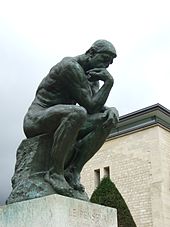
In the second part of the 19th century, France's influence over painting became even more important, with the development of new styles of painting such as Impressionism and Symbolism. The most famous impressionist painters of the period were Camille Pissarro, Édouard Manet, Edgar Degas, Claude Monet and Auguste Renoir. The second generation of impressionist-style painters, Paul Cézanne, Paul Gauguin, Toulouse-Lautrec and Georges Seurat, were also at the avant-garde of artistic evolutions, as well as the fauvist artists Henri Matisse, André Derain and Maurice de Vlaminck.
At the beginning of 20th century, Cubism was developed by Georges Braque and the Spanish painter Pablo Picasso, living in Paris. Other foreign artists also settled and worked in or near Paris, such as Vincent van Gogh, Marc Chagall, Amedeo Modigliani and Wassily Kandinsky.
Many museums in France are entirely or partly devoted to sculptures and painting works. A huge collection of old masterpieces created before or during the 18th century are displayed in the state-owned Musée du Louvre, such as Mona Lisa, also known as La Joconde. While the Louvre Palace has been for a long time a museum, the Musée d'Orsay was inaugurated in 1986 in the old railway station Gare d'Orsay, in a major reorganization of national art collections, to gather French paintings from the second part of the 19th century (mainly Impressionism and Fauvism movements).
Modern works are presented in the Musée National d'Art Moderne, which moved in 1976 to the Centre Georges Pompidou. These three state-owned museums welcome close to 17 million people a year. Other national museums hosting paintings include the Grand Palais (1.3 million visitors in 2008), but there are also many museums owned by cities, the most visited being the Musée d'Art Moderne de la Ville de Paris (0.8 million entries in 2008), which hosts contemporary works.
Outside Paris, all the large cities have a Museum of Fine Arts with a section dedicated to European and French painting. Some of the finest collections are in Lyon, Lille, Rouen, Dijon, Rennes and Grenoble.
ស្ថាបត្យកម្ម
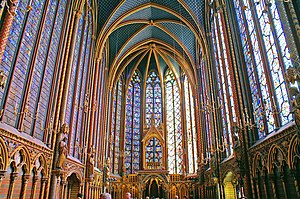


During the Middle Ages, many fortified castles were built by feudal nobles to mark their powers. Some French castles that survived are Chinon, Château d'Angers, the massive Château de Vincennes and the so-called Cathar castles. During this era, France had been using Romanesque architecture like most of Western Europe. Some of the greatest examples of Romanesque churches in France are the Saint Sernin Basilica in Toulouse, the largest romanesque church in Europe, and the remains of the Cluniac Abbey.
The Gothic architecture, originally named Opus Francigenum meaning « French work », was born in Île-de-France and was the first French style of architecture to be copied in all Europe. Northern France is the home of some of the most important Gothic cathedrals and basilicas, the first of these being the Saint Denis Basilica (used as the royal necropolis); other important French Gothic cathedrals are Notre-Dame de Chartres and Notre-Dame d'Amiens. The kings were crowned in another important Gothic church: Notre-Dame de Reims. Aside from churches, Gothic Architecture had been used for many religious palaces, the most important one being the Palais des Papes in Avignon.
The final victory in the Hundred Years' War marked an important stage in the evolution of French architecture. It was the time of the French Renaissance and several artists from Italy were invited to the French court; many residential palaces were built in the Loire Valley. Such residential castles were the Château de Chambord, the Château de Chenonceau, or the Château d'Amboise.
Following the renaissance and the end of the Middle Ages, Baroque architecture replaced the traditional Gothic style. However, in France, baroque architecture found a greater success in the secular domain than in a religious one. In the secular domain, the Palace of Versailles has many baroque features. Jules Hardouin Mansart, who designed the extensions to Versailles, was one of the most influential French architect of the baroque era; he is famous for his dome at Les Invalides. Some of the most impressive provincial baroque architecture is found in places that were not yet French such as the Place Stanislas in Nancy. On the military architectural side, Vauban designed some of the most efficient fortresses in Europe and became an influential military architect; as a result, imitations of his works can be found all over Europe, the Americas, Russia and Turkey.
After the Revolution, the Republicans favoured Neoclassicism although neoclassicism was introduced in France prior to the revolution with such building as the Parisian Pantheon or the Capitole de Toulouse. Built during the first French Empire, the Arc de Triomphe and Sainte Marie-Madeleine represent the best example of Empire style architecture.
Under Napoleon III, a new wave of urbanism and architecture was given birth; extravagant buildings such as the neo-baroque Palais Garnier were built. The urban planning of the time was very organised and rigorous; for example, Haussmann's renovation of Paris. The architecture associated to this era is named Second Empire in English, the term being taken from the Second French Empire. At this time there was a strong Gothic resurgence across Europe and in France; the associated architect was Eugène Viollet-le-Duc. In the late 19th century, Gustave Eiffel designed many bridges, such as Garabit viaduct, and remains one of the most influential bridge designers of his time, although he is best remembered for the iconic Eiffel Tower.
In the 20th century, French-Swiss architect Le Corbusier designed several buildings in France. More recently, French architects have combined both modern and old architectural styles. The Louvre Pyramid is an example of modern architecture added to an older building. The most difficult buildings to integrate within French cities are skyscrapers, as they are visible from afar. For instance, in Paris, since 1977, new buildings had to be under 37 meters, or 121 feet. France's largest financial district is La Defense, where a significant number of skyscrapers are located. Other massive buildings that are a challenge to integrate into their environment are large bridges; an example of the way this has been done is the Millau Viaduct. Some famous modern French architects include Jean Nouvel, Dominique Perrault, Christian de Portzamparc or Paul Andreu.
អក្សរសិល្ប៍
The earliest French literature dates from the Middle Ages, when what is now known as modern France did not have a single, uniform language. There were several languages and dialects and writers used their own spelling and grammar. Some authors of French mediaeval texts are unknown, such as Tristan and Iseult and Lancelot-Grail. Other authors are known, for example Chrétien de Troyes and Duke William IX of Aquitaine, who wrote in Occitan.
Much mediaeval French poetry and literature were inspired by the legends of the Matter of France, such as The Song of Roland and the various chansons de geste. The Roman de Renart, written in 1175 by Perrout de Saint Cloude, tells the story of the mediaeval character Reynard ('the Fox') and is another example of early French writing.
An important 16th-century writer was François Rabelais, whose novel Gargantua and Pantagruel has remained famous and appreciated until now. Michel de Montaigne was the other major figure of the French literature during that century. His most famous work, Essais, created the literary genre of the essay. French poetry during that century was embodied by Pierre de Ronsard and Joachim du Bellay. Both writers founded the La Pléiade literary movement.
During the 17th century, Madame de La Fayette published anonymously La Princesse de Clèves, a novel that is considered to be one of the very first psychological novels of all times. Jean de La Fontaine is one of the most famous fabulist of that time, as he wrote hundreds of fables, some being far more famous than others, such as The Ant and the Grasshopper. Generations of French pupils had to learn his fables, that were seen as helping teaching wisdom and common sense to the young people. Some of his verses have entered the popular language to become proverbs.
Jean Racine, whose incredible mastery of the alexandrine and of the French language has been praised for centuries, created plays such as Phèdre or Britannicus. He is, along with Pierre Corneille (Le Cid) and Molière, considered as one of the three great dramatists of the France's golden age. Molière, who is deemed to be one of the greatest masters of comedy of the Western literature, wrote dozens of plays, including Le Misanthrope, L'Avare, Le Malade imaginaire, and Le Bourgeois Gentilhomme. His plays have been so popular around the world that French language is sometimes dubbed as "the language of Molière" (la langue de Molière), just like English is considered as "the language of Shakespeare".
French literature and poetry flourished even more in the 18th and 19th centuries. Denis Diderot's best-known works are Jacques the Fatalist and Rameau's Nephew. He is however best known for being the main redactor of the Encyclopédie, whose aim was to sum up all the knowledge of his century (in fields such as arts, sciences, languages, philosophy) and to present them to the people, in order to fight ignorance and obscurantism. During that same century, Charles Perrault was a prolific writer of famous children's fairy tales including Puss in Boots, Cinderella, Sleeping Beauty and Bluebeard. At the start of the 19th century, symbolist poetry was an important movement in French literature, with poets such as Charles Baudelaire, Paul Verlaine and Stéphane Mallarmé.
The 19th century saw the writings of many renowned French authors. Victor Hugo is sometimes seen as "the greatest French writer of all times" for excelling in all literary genres. The preface of his play Cromwell is considered to be the manifesto of the Romantic movement. Les Contemplations and La Légende des siècles are considered as "poetic masterpieces", Hugo's verse having been compared to that of Shakespeare, Dante and Homer. His novel Les Misérables is widely seen as one of the greatest novel ever written and The Hunchback of Notre Dame has remained immensely popular.
Other major authors of that century include Alexandre Dumas (The Three Musketeers and The Count of Monte-Cristo), Jules Verne (Twenty Thousand Leagues Under the Sea), Émile Zola (Les Rougon-Macquart), Honoré de Balzac (La Comédie humaine), Guy de Maupassant, Théophile Gautier and Stendhal (The Red and the Black, The Charterhouse of Parma), whose works are amongst the most well known in France and the world.
The Prix Goncourt is a French literary prize first awarded in 1903. Important writers of the 20th century include Marcel Proust, Louis-Ferdinand Céline, Albert Camus, and Jean-Paul Sartre. Antoine de Saint Exupéry wrote Little Prince which has remained popular for decades with children and adults around the world. As of 2010, French authors had more Literature Nobel Prizes than those of any other nation.
ទស្សនវិជ្ជា
Medieval philosophy was dominated by Scholasticism until the emergence of Humanism in the Renaissance. Modern philosophy began in France in the 17th century with the philosophy of René Descartes, Blaise Pascal, and Nicolas Malebranche. Descartes revitalised Western philosophy, which had been declined after the Greek and Roman eras. His Meditations on First Philosophy changed the primary object of philosophical thought and raised some of the most fundamental problems for foreigners such as Spinoza, Leibniz, Hume, Berkeley, and Kant.
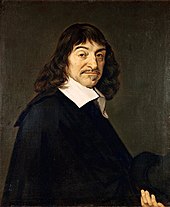
During the 18th century, French philosophers produced one of the most important works of the Age of Enlightenment. In The Spirit of the Laws, Baron de Montesquieu theorized the principle of separation of powers, which has been implemented in all liberal democracies since it was first applied in the United States. In The Social Contract, Jean-Jacques Rousseau openly criticized the European divine right monarchies and strongly affirmed the principle of the sovereignty of the people. Voltaire came to embody the Enlightenment with his defence of civil liberties, such as the right to a free trial and freedom of religion.
19th-century French thought was targeted at responding to the social malaise following the French Revolution. Rationalist philosophers such as Victor Cousin and Auguste Comte, who called for a new social doctrine, were opposed by reactionnary thinkers such as Joseph de Maistre, Louis de Bonald and Lamennais, who blamed the rationalist rejection of traditional order. De Maistre is considered, together with the Englishman Edmund Burke, one of the founders of European conservatism, while Comte is regarded as the founder of positivism and sociology.
In the early 20th century, French spiritualist thinkers such as Maine de Biran, Henri Bergson and Louis Lavelle influenced Anglo-Saxon thought, including the Americans Charles Sanders Peirce and William James, and the Englishman Alfred North Whitehead. In the late 20th century, partly influenced by German phenomenology and existentialism, postmodern philosophy began in France, with notable post-structuralist thinkers including Jean-François Lyotard, Jean Baudrillard, Jacques Derrida, Jacques Lacan, Michel Foucault and Gilles Deleuze.
Sciences

France has been since the Middle Ages a major focus of knowledge and discoveries. Around the beginning of the 11th century Pope Sylvester II reintroduced the abacus and armillary sphere, and introduced Arabic numerals and clocks to northern and western Europe. The University of Paris, founded in the mid-12th century, is still one of the most important universities of the Western world.
In the 17th century, René Descartes defined a method for the acquisition of scientific knowledge, while Blaise Pascal became famous for his work on probability and fluid mechanics. They were both key figures of the Scientific revolution which erupted in Europe during this period. The Academy of Sciences was founded by Louis XIV to encourage and protect the spirit of French scientific research. It was at the forefront of scientific developments in Europe in the 17th and 18th centuries. It is one of the earliest academies of sciences.
The Age of Enlightenment was marked by the work of biologist Buffon and chemist Lavoisier, who discovered the role of oxygen in combustion, while Diderot and D'Alembert published the Encyclopédie which aimed to give access to "useful knowledge" to the people, a knowledge that they can apply to their everyday life.
With the Industrial Revolution, the 19th century saw spectacular scientific developments in France with scientists such as Augustin Fresnel, founder of modern optics, Sadi Carnot who laid the foundations of thermodynamics, or Louis Pasteur, a pioneer of microbiology. Other eminent French scientists of the 19th century have their names inscribed on the Eiffel Tower.
Famous French scientists of the 20th century include the mathematician and physicist Henri Poincaré, physicists Henri Becquerel, Pierre and Marie Curie, remained famous for their work on radioactivity, the physicist Paul Langevin or virologist Luc Montagnier, co-discoverer of HIV AIDS.
As of 2012, 65 French people have been awarded a Nobel Prize and 11 have received the Fields Medal.
តន្ត្រី
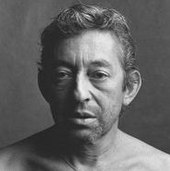
France has a long and varied musical history. It experienced a golden age in the 17th century thanks to Louis XIV, who employed several musicians and composers in the royal court. The most renowned composers of this period include Marc-Antoine Charpentier, François Couperin, Michel-Richard Delalande, Jean-Baptiste Lully and Marin Marais, all of them composers at the court. After the death of the "Roi Soleil", French musical creation lost dynamism, but in the next century the music of Jean-Philippe Rameau reached some prestige, and today he is still one of the most renowned French composers.
French classical music knew a revival in the 19th and 20th century, at the end of the romantic movement, at first with opera composers Hector Berlioz, Georges Bizet, Gabriel Fauré, Charles Gounod, Jacques Offenbach, Édouard Lalo, Jules Massenet and Camille Saint-Saëns. This period was a golden age for operas, being popular in the country the opéra bouffon, the opera-ballet and the opéra comique genres. Later came precursors of modern classical music Érik Satie, Francis Poulenc, and above all Maurice Ravel and Claude Debussy, who invented new musical forms. More recently, at the middle of the 20th century, Maurice Ohana, Pierre Schaeffer and Pierre Boulez contributed to the evolutions of contemporary classical music.

French music then followed the rapid emergence of pop and rock music at the middle of the 20th century. Although English-speaking creations achieved popularity in the country, French pop music, known as chanson française, has also remained very popular. Among the most important French artists of the century are Édith Piaf, Georges Brassens, Léo Ferré, Charles Aznavour and Serge Gainsbourg. Although there are very few rock bands in France compared to English-speaking countries, bands such as Noir Désir, Mano Negra, Niagara, Les Rita Mitsouko and more recently Superbus, Phoenix and Gojira have reached worldwide popularity.
Other French artists with international careers have been popular in several countries, for example female singers Dalida, Mireille Mathieu and Mylène Farmer, electronic music pioneers Jean-Michel Jarre, Laurent Garnier and Bob Sinclar, and later Martin Solveig and David Guetta. In the 1990s and 2000s (decade), electronic duos Daft Punk, Justice and Air also reached worldwide popularity and contributed to the reputation of modern electronic music in the world.
Among current musical events and institutions in France, many are dedicated to classical music and operas. The most prestigious institutions are the state-owned Paris National Opera (with its two sites Palais Garnier and Opéra Bastille), the Opéra National de Lyon, the Théâtre du Châtelet in Paris, the Théâtre du Capitole in Toulouse and the Grand Théâtre de Bordeaux. As for music festivals, there are several events organized, the most popular being the Eurockéennes and Rock en Seine. The Fête de la Musique, imitated by many foreign cities, was first launched by the French government in 1982. Major music halls and venues in France include Le Zénith sites present in many cities and other places in Paris (Paris Olympia, Théâtre Mogador, Élysée Montmartre, etc.).
Cinema

France has historical and strong links with cinema, with two Frenchmen, Auguste and Louis Lumière (known as the Lumière Brothers) having created cinema in 1895. France remains a leader in filmmaking, as of 2006 producing more films than any other European country. The nation also hosts the Cannes Festival, one of the most important and famous film festivals in the world.
Although the French film market is dominated by Hollywood, France is the only nation in the world where American films make up the smallest share of total film revenues, at 50%, compared with 77% in Germany and 69% in Japan. French films account for 35% of the total film revenues of France, which is the highest percentage of national film revenues in the developed world outside the United States, compared to 14% in Spain and 8% in the UK.
Until recently, France had for centuries been the cultural center of the world, although its dominant position has been surpassed by the United States. Subsequently, France takes steps in protecting and promoting its culture, becoming a leading advocate of the cultural exception. The nation succeeded in convincing all EU members to refuse to include culture and audiovisuals in the list of liberalized sectors of the WTO in 1993.
Moreover, this decision was confirmed in a voting in the UNESCO in 2005, and the principle of "cultural exception" won an overwhelming victory: 198 countries voted for it, only 2 countries, the U.S and Israel, voted against it.
Fashion

Fashion has been an important industry and cultural export of France since the 17th century, and modern "haute couture" originated in Paris in the 1860s. Today, Paris, along with London, Milan, and New York City, is considered one of the world's fashion capitals, and the city is home or headquarters to many of the premier fashion houses. The expression Haute couture is, in France, a legally protected name, guaranteeing certain quality standards.
The association of France with fashion and style (បារាំង: la mode) dates largely to the reign of Louis XIV when the luxury goods industries in France came increasingly under royal control and the French royal court became, arguably, the arbiter of taste and style in Europe. But France renewed its dominance of the high fashion (បារាំង: couture or haute couture) industry in the years 1860–1960 through the establishing of the great couturier houses such as Chanel, Dior, and Givenchy. The French perfume industry is world leader in its sector and is centered around the town of Grasse.
In the 1960s, the elitist "Haute couture" came under criticism from France's youth culture. In 1966, the designer Yves Saint Laurent broke with established Haute Couture norms by launching a prêt-à-porter ("ready to wear") line and expanding French fashion into mass manufacturing. With a greater focus on marketing and manufacturing, new trends were established by Sonia Rykiel, Thierry Mugler, Claude Montana, Jean-Paul Gaultier and Christian Lacroix in the 1970s and 1980s. The 1990s saw a conglomeration of many French couture houses under luxury giants and multinationals such as LVMH.
ប្រព័ន្ធផ្សព្វផ្សាយ
Compared to other developed countries, the French do not spend much time reading newspapers, due to the popularity of broadcast media. Best-selling daily national newspapers in France are Le Monde and Le Figaro, with around 300,000 copies sold daily, but also L'Équipe, dedicated to sports coverage. In the past years, free dailies made a breakthrough, with Metro, 20 Minutes and Direct Plus distributed at more than 650,000 copies respectively. However, the widest circulations are reached by regional daily Ouest France with more than 750,000 copies sold, and the 50 other regional papers have also high sales. The sector of weekly magazines is stronger and diversified with more than 400 specialized weekly magazines published in the country.
The most influential news magazine are left-wing Le Nouvel Observateur, centrist L'Express and right-wing Le Point (more than 400.000 copies), but the highest circulation for weeklies is reached by TV magazines and by women’s magazines, among them Marie Claire and ELLE, which have foreign versions. Influential weeklies also include investigative and satirical papers Le Canard Enchaîné and Charlie Hebdo, as well as Paris Match. Like in most industrialized nations, the print media have been affected by a severe crisis in the past decade. In 2008, the government have launched a major initiative to help the sector reform to be financially independent, but in 2009 it had to give 600.000 euros to help the print media cope with the economic crisis, in addition to existing subsidies.
In 1974, after years of centralized monopoly on radio and television, the governmental agency ORTF was split into several national institutions, but the three already-existing TV channels and four national radio stations remained under state-control. It was only in 1981 that the government allowed free broadcasting in the territory, ending state monopoly on radio. French television was partly liberalized in the next two decade with the creation of several commercial channels, mainly thanks to cable and satellite television. In 2005 the national service Télévision Numérique Terrestre introduced digital television all over the territory, allowing the creation of other channels.
The four existing national channels are now owned by state-owned consortium France Télévisions, while public broadcasting group Radio France run five national radio stations. Among these public media are Radio France Internationale, which broadcasts programs in French all over the world, and Franco-German TV channel TV5 Monde. In 2006, the government created global news channel France 24. Long-established TV channels TF1 (privatized in 1987), France 2 and France 3 have the highest shares, while radio stations RTL, Europe 1 and state-owned France Inter are the least listened to.
សង្គម

According to a BBC poll in 2010, based on 29,977 responses in 28 countries, France is globally seen as a positive influence in the world's affairs: 49% have a positive view of the country's influence, whereas 19% have a negative view. The Nation Brand Index of 2008 suggested that France has the second best international reputation, only behind Germany.
According to a poll in 2011, the French were found to have the highest level of religious tolerance and to be the country where the highest proportion of the population defines its identity primarily in term of nationality and not religion. 69% of French have a favourable view of the US, making France one of the most pro-American countries in the world.
In January 2010, the magazine International Living ranked France as "best country to live in", ahead of 193 other countries, for the fifth year running.
The four official symbols of the Republic, as stated by the Constitution, all commemorate events from the French Revolution. Bastille Day, the national holiday, commemorates the Fête de la Fédération, held on 14 July 1790 to celebrate the storming of the Bastille. The origins of the Tricolour flag date to the Revolution, as the cockade was the symbols adopted by the revolutionaries in 1789.
The national anthem, La Marseillaise, was written in 1792 as a war song for the French Army. The official motto of the French Republic, "Liberté, égalité, fraternité" (Liberty, equality, brotherhood), also appeared during the Revolution. Marianne, an unofficial symbol, is an allegorical figure of liberty and the Republic, and appeared at the time of the Revolution.
A common and traditional symbol of the French people is the Gallic rooster. Its origins date back to Antiquity, since the Latin word Gallus meant both "rooster" and "inhabitant of Gaul". Then this figure gradually became the most widely shared representation of the French, used by French monarchs, then by the Revolution and under the successive republican regimes as representation of the national identity, used for some stamps and coins.
Gastronomy

French cuisine is renowned for being one of the finest in the world. French cuisine is extremely diverse and has exerted a major influence on other western cuisines. According to the regions, traditional recipes are different, the North of the country prefers to use butter as the preferred fat for cooking, whereas olive oil is more commonly used in the South.
Moreover, each region of France has iconic traditional specialities : Cassoulet in the Southwest, Choucroute in Alsace, Quiche in the Lorraine region, Beef bourguignon in the Bourgogne, provençal Tapenade, etc. France's most renowned products are wines, including Champagne, Bordeaux, Bourgogne, and Beaujolais as well as a large variety of different cheeses, such as Camembert, Roquefort and Brie. There are more than 400 different varieties.
French cuisine is also regarded as a key element of the quality of life and the attractiveness of France. A French publication, the Michelin guide, had by 2006 awarded 620 stars to French restaurants, at that time more than any other country, although the guide also inspects more restaurants in France than in any other country (by 2010, Japan was awarded as many Michelin stars as France, despite having half the number of Michelin inspectors working there).
កីឡា

Popular sports played in France include football, judo, tennis and basketball. France has hosted events such as the 1938 and 1998 FIFA World Cups, and the 2007 Rugby World Cup. Stade de France in Saint-Denis is France's largest stadium and was the venue for the 1998 FIFA World Cup and 2007 Rugby World Cup finals. France hosts the annual Tour de France, the most famous road bicycle race in the world. France is famous for its 24 Hours of Le Mans sports car endurance race. Several major tennis tournaments take place in France, including the Paris Masters and the French Open, one of the four Grand Slam tournaments. French martial arts include Savate and Fencing.
France has a close association with the Modern Olympic Games; it was a French aristocrat, Baron Pierre de Coubertin, who suggested the Games' revival, at the end of the 19th century. After Athens was awarded the first Games, in reference to the Olympics' Greek origins, Paris hosted the second Games in 1900. Paris was the first home of the International Olympic Committee, before it moved to Lausanne. Since 1900, France has hosted the Olympics on 4 further occasions: the 1924 Summer Olympics, again in Paris and three Winter Games (1924 in Chamonix, 1968 in Grenoble and 1992 in Albertville).

Both the national football team and the national rugby union team are nicknamed “Les Bleus” in reference to the team’s shirt color as well as the national French tricolor flag. Football is the most popular sport in France, with over 1,800,000 registered players, and over 18,000 registered clubs. The football team is among the most successful in the world, particularly at the start of the 21st century, with one FIFA World Cup victory in 1998, one FIFA World Cup second place in 2006, and two UEFA European Championships in 1984 and 2000. The top national football club competition is Ligue 1. France has produced some of the greatest players in the world, including three time FIFA World Player of the Year Zinedine Zidane, three time Ballon d'Or recipient Michel Platini, record holder for most goals scored at a World Cup Just Fontaine, first football player to receive the Légion d'honneur Raymond Kopa, and the all-time leading goalscorer for the French national team Thierry Henry.
Rugby union is popular, particularly in Paris and the southwest of France. The national rugby union team has competed at every Rugby World Cup, and takes part in the annual Six Nations Championship. Stemming from a strong domestic league, the French rugby team has won 16 Six Nations Championships, including 8 grand slams; and has reached the semi-final of the Rugby World Cup 6 times and the final 3 times.
Rugby league in France is a sport that is most popular in the south, in cities such as Perpignan and Toulouse. The Catalans Dragons currently play in the Super League, which is the top tier rugby league competition in Europe. The Elite One Championship is the professional competition for rugby league clubs in France.
In recent decades, France has produced world-elite basketball players, most notably Tony Parker. The French National Basketball Team won gold at the FIBA EuroBasket 2013. The national team has won two Olympic Silver Medals: in 2000 and 1948.
កំណត់សម្គាល់
| ស្វែងយល់បន្ថែមអំពីFranceលើ គម្រោងបងប្អូនរបស់វិគីភីឌា: | |
 | និយមន័យនិងបំណកប្រែពីវិគីនានុក្រម |
 | រូបភាពនិងមីឌាពី Wiki Commons |
 | ប្រភពរៀនសូត្រពីវិគីសាកលវិទ្យាល័យ |
 | រឿងរ៉ាវព័ត៌មានពីវិគីព័ត៌មាន |
 | សម្រង់ពាក្យសម្ដីពីវិគីសម្រង់ពាក្យ |
 | អត្ថបទប្រភពដើមពីវិគីប្រភព |
 | សៀវភៅពុម្ពពីវិគីសៀវភៅ |
- France from the BBC News
- France at UCB Libraries GovPubs
- បារាំង នៅគម្រោងបញ្ជីរាយឈ្មោះបើកទូលាយ
- France Encyclopædia Britannica entry
- France at the EU
- សៀវភៅផែនទីវិគីមីឌាFrance
 Geographic data related to បារាំង at OpenStreetMap
Geographic data related to បារាំង at OpenStreetMap- Key Development Forecasts for France from International Futures
- Economy
- ទំព័រគំរូ:INSEE
- OECD France statistics
- Government
- France.fr (in English) Official French tourism website
- (បារាំង) Official Site of the Government
- Official site of the French public service Archived 2012-01-03 at the វេយប៊ែខ ម៉ាស៊ីន. – Links to various administrations and institutions
- Chief of State and Cabinet Members Archived 2011-05-01 at the វេយប៊ែខ ម៉ាស៊ីន. on The World Factbook
- Official site of the National Assembly
- Culture
- ទំព័រគំរូ:En-icon Contemporary French Civilization Archived 2012-03-08 at the វេយប៊ែខ ម៉ាស៊ីន., journal, University of Illinois.
- FranceGuide – Official website of the French Government Tourist Office
ទំព័រគំរូ:France topics
2°E / 47°N 2°E
ប្រភពពត៌មាន
This article uses material from the Wikipedia ភាសាខ្មែរ article បារាំង, which is released under the Creative Commons Attribution-ShareAlike 3.0 license ("CC BY-SA 3.0"); additional terms may apply (view authors). ខ្លឹមសារអត្ថបទប្រើប្រាស់បានក្រោមអាជ្ញាបណ្ឌCC BY-SA 4.0 លើកលែងតែមានបញ្ជាក់ផ្សេងពីនោះ។ Images, videos and audio are available under their respective licenses.
®Wikipedia is a registered trademark of the Wiki Foundation, Inc. Wiki ភាសាខ្មែរ (DUHOCTRUNGQUOC.VN) is an independent company and has no affiliation with Wiki Foundation.



